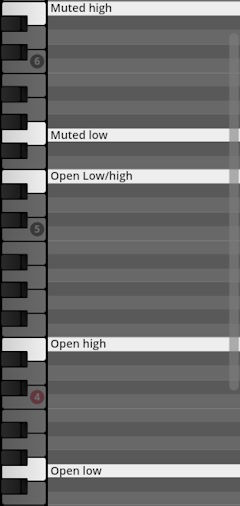SYNCHRON-ized Percussion
Introduction
Welcome to the Vienna Symphonic Library’s series of Synchron Instruments!
SYNCHRON-ized Percussion is based on the original VI Percussion Collection and includes the updated sample database of instruments that were recorded in the tight and controlled ambience of our second studio, the Silent Stage. All drums and percussion instruments can therefore be placed in any acoustic environment and at any position in a room, from dry closets to halls and venues such as the rooms provided by Vienna MIR Pro 3D.
The collection's six separately available Percussion Packs correspond to the instruments of the Synchron Percussion Packs, with equal mappings to make it easy to exchange and try out instruments from both Series. However, the instruments of the SYNCHRON-ized Percussion Collection were not only recorded in a different acoustic environment, they're also different makes of the same instruments with their own individual sound characteristics, and were played by different musicians, providing your own percussion arsenal with more flexibility and variety.
The entire sample database was optimized for the Vienna Synchron Player and its advanced algorithms and features. The instruments were furnished with customized impulse responses so that they can easily be placed in their ideal spot on the virtual Synchron Stage Vienna. The volume levels of all articulations such as single hits, dynamic rolls and many more have been precisely adjusted and matched, balancing the dynamic ranges of all instruments for seamless, natural performances when switching through various articulations. Moreover, the dynamic rolls of timpani, bass drums and taikos can be played shorter than their original length due to the release sample algorithms of the Synchron Player.
All instruments offer a broad spectrum of meticulously sampled articulations, from single hits with various beaters to static rolls, crescendo and diminuendo rolls, upbeats and repetitions, depending on the styles and variations each instrument has to offer.
Presets
Synchron(-ized) libraries generally offer different Presets according to how velocity is handled, arranged in separate folders.
- “VelXF rolls”: velocity crossfading is only activated for rolls, while the dynamics of other patches are controlled by keystroke velocity, thus facilitating phrasing.
- “VelXF”: all articulations have velocity crossfading activated so that you can control dynamics with MIDI controller CC1, the modwheel.
- “Velocity”: note volume is controlled by keystroke velocity just like a piano.
Apart from that, velocity crossfading can always be enabled or disabled by clicking its on/off symbol in the Synchron Player's Perform tab.
Switching between instruments and articulation styles (e.g., diferent beaters) is generally done via dedicated keys on the keyboard which are therefore called “keyswitches”.
Mixer Presets
For a perfect sound "out of the box" the instruments come with customized Mixer Presets such as Close, Classic, Distant, without reverb, short reverb with and without the Synchron Player's included MIR convolution technology, which guarantee a perfect sound and match the acoustic placement of the Synchron Series instruments that were recorded on the large Stage A of our Hollywood-approved scoring stage.
There also is a MIR Unprocessed Mixer Preset for use with the concert halls and studios of our renowned convolution engine.
Concert toms, Taikos, and Rails offer additional "Wide" sets of Mixer Presets where the instruments are placed in different positions througout the Synchron Stage, allowing you to let several players play in cinemascope, so to speak.
Patches and mapping
Patches can be used to build your own custom Presets and adapt the Synchron Libraries to your specific requirements. For further information on constructing Presets, please see the Synchron Player manual.
Many of the unpitched percussion instruments have single strokes, rolls, und dynamic rolls distributed to different patches, which are then stacked in the Presets. This had the advantage of allowing different treatment in their mapping. For instance, it was thus possible to create VelXF Rolls Presets where the dynamics of rolls can be controlled with velocity crossfading, while the dynamics of single strokes react to keystroke velocity.
Repetitions (with the exception of dynamic repetitions) are generally mapped to two adjacent keys. For best effect, these should be played alternately.
Pitch
For designating pitch, the Vienna Symphonic Library uses International Pitch Notation (IPN), which was agreed upon internationally under the auspices of the Acoustical Society of America. In this system the international standard of A=440 Hz is called A4 and middle C is C4. All pitches are written as capital letters, their respective octave being indicated by a number next to it. The lowest C on the piano is C1 (the A below that is A0), etc.
The Synchron Player software allows you to set middle C to C3, C4, or C5 according to your preference. Selecting another setting than C4 will of course also change the play ranges and keyswitches accordingly.
Timpani
The timpani, or kettledrum, an established member of the symphony orchestra since the 17th century, is the percussion instrument with the longest tradition. It is a skin-covered instrument with definite pitch. As the loudest of all orchestra instruments it requires tremendous precision of the timpanist.
In Romantic and modern works four timpani are usual. In the Classical period one pair was standard. The kettledrum has a range of about a sixth. A timpani group composed of several instruments covers approximately two octaves (B1–C3).
In modern-day notation the timpani part is written non-transposing, always in bass clef.
Timpani A
Single strokes
Performance repetitions
Static rolls
Dynamic rolls medium and strong
Glissando rolls
Glissandos
Upbeats
Range: Single strokes, rolls, upbeats C2–C4; glissandos according to interval.
Articulation switches: F1–B1.
Type switches: starting at C7.
Single strokes
Single strokes open and secco; performance repetitions slow and fast.
- Mapping: left hand C2–C4; right hand C5–C6.
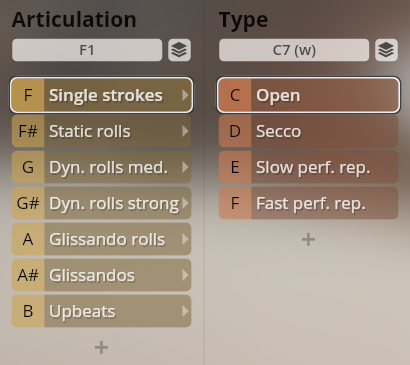
Static rolls
Static rolls, normal and short release.
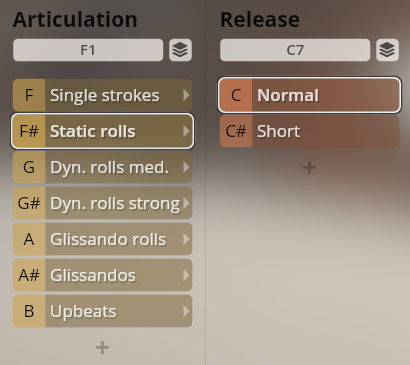
Dynamic rolls
Dynamic rolls, medium and strong, 1/2/3/4/6 sec.
- Cresc/dim: A0/B0.
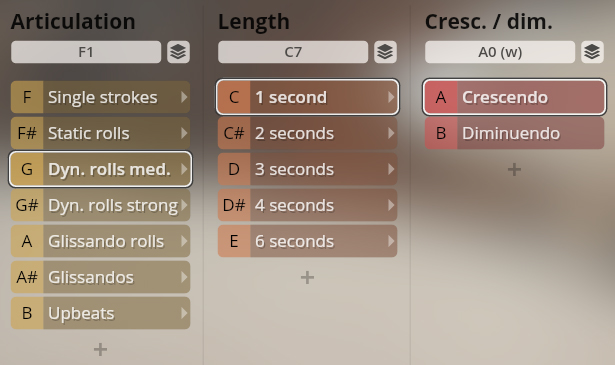
Glissando rolls, glissandos
Glissando rolls and glissandos, 4th and 5th, up and down.
- Play range: fourth up C2–G3, down F2–C4; fifth up C2–F3, down G2–C4.
- Interval: E7/F7.
- Up/down: A0/B0.
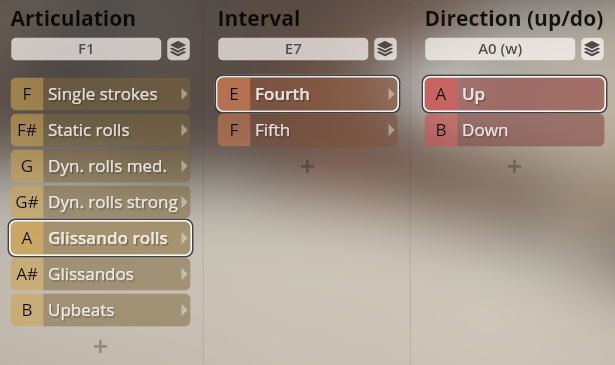
Upbeats
1–3 upbeats.

TIMPANI B
Medium soft, medium hard, hard, wood, and felt mallets, fingers
Single strokes
Rolls static
Rolls dynamic
Glissando rolls
Glissandos
Upbeats
Articulations according to beater
Range: Single strokes C2–A#5 (split left/right hand); rolls and upbeats C2–A#3; glissandos vary according to interval.
Mallets: C1–E1
Articulations: F1–B1.
Type switches: starting at C7.
Medium soft mallets, Wood mallets
Single strokes; static rolls; dynamic rolls; glissando rolls; glissandos; upbeats.
Single strokes
Single strokes open, secco, and coperto; performance repetitions slow, medium, and fast.
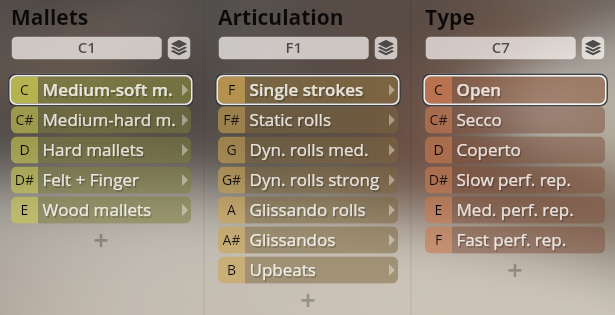
Static rolls
Static rolls, normal and short release.
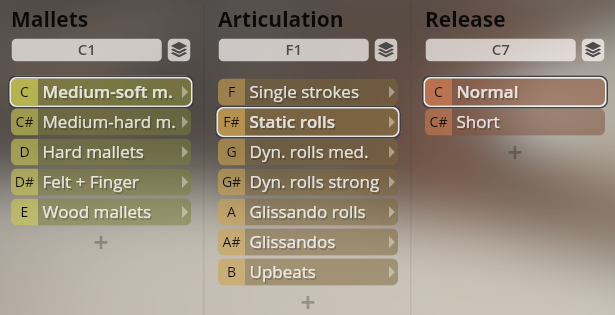
Dynamic rolls
Dynamic rolls medium and strong, 1/2/4 sec.
- Cresc/dim: A0/B0.
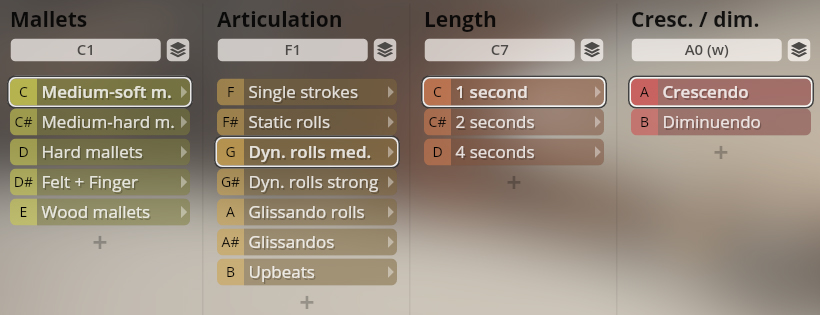
Glissando rolls, glissandos
Glissando rolls and glissandos, 1/2 sec., minor 2nd to major 3rd, up; 4th, up and down.
- Up/down: A0/B0.
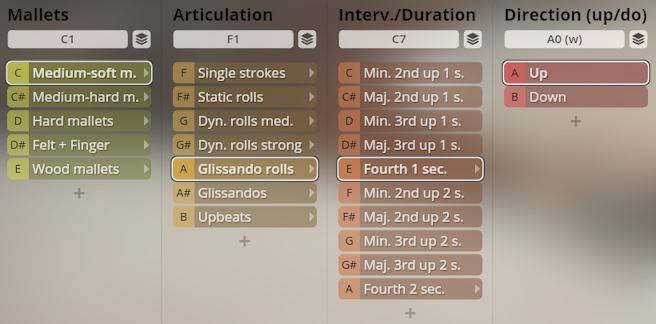
Upbeats
1–4 upbeats.
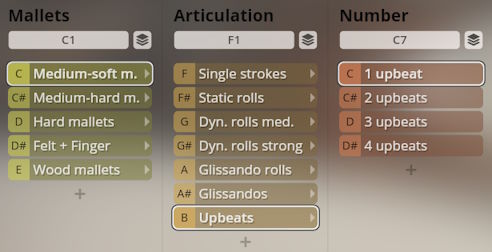
Medium hard mallets
Single strokes.
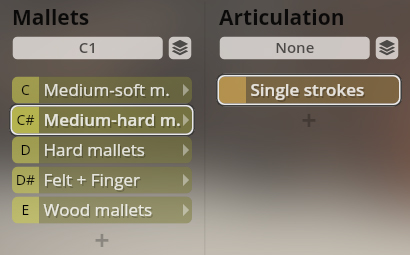
Hard mallets
Single strokes; static rolls; dynamic rolls, strong; upbeats
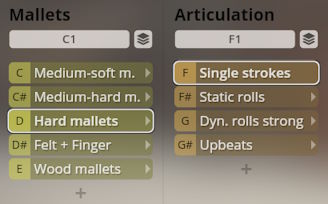
Static rolls
Static rolls, normal and short release.
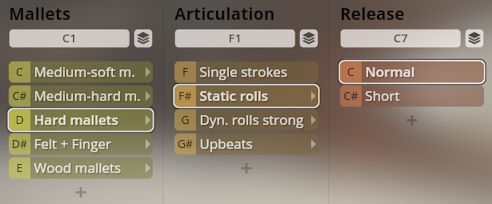
Dynamic rolls
Rolls strong dynamics, 1/2/4 sec.
- Cresc/dim: A0/B0.

Upbeats
1–4 upbeats.
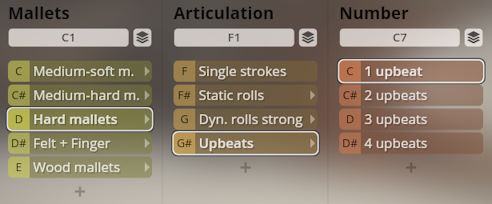
Felt + finger
Single strokes played with felt mallets and with fingers.
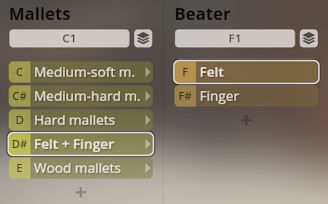
Timpani processed
Single strokes, dry and wet; static rolls, dry and wet. Use Dim.Ctrl/A (MIDI CC3) to adjust the amount of dry/wet signal.
- Single/rolls: F1/F#1.
- Dry /wet amount: Dim.Ctrl/A (MIDI CC3).
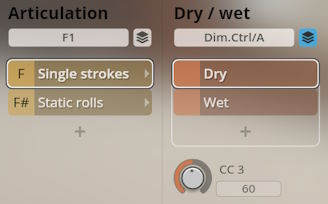
Drums
In most cultures, the drum in its various forms is the most important and rudimentary percussion.
The snare drum is found in practically every type of western music from military music (where its roots lie) to jazz or the drum kits of rock and pop. At the same time the snare drum is a crucial member of the orchestral percussion section. Extremely shallow versions of the snare drum have become known as piccolo snare drums.
The bass drum plays an essential role in several western musical styles as well. Its variable timbre can be used to mark the rhythm not only in large orchestras but also in small ensembles: in military music, where it is played together with the cymbal, or in pop, rock and jazz, where it is played using the bass pedal as part of the drum kit.
The field drum or tenor drum is used in the orchestra as well as in military and wind bands. It ranks between the snare drum and the bass drum in both size and pitch. Depending on the region it may be snared or unsnared.
The tambourine has been an important folk instrument in many European cultures from time immemorial. Today it is especially common in Mediterranean countries where it serves as a rhythm instrument accompanying songs and dances. It is either struck with the hand or shaken. In the orchestra, where it is used as a rhythm and noise instrument to add color and suggest dance scenes, it has had a place since the 19th century.
- Instruments
- Snare drum A and B
- Snare drum ensemble, 4 players
- Piccolo drum
- Field drum A and B
- Bass drum A and B
- Taikos
- Concert toms
- Roto toms
- Tambourines
Snare A
Snares on and off; single strokes; static rolls; dynamic rolls; dynamic repetitions.
- Stroke mode: C1/C#1.
- Snares on/off: A0/B0.
Normal
Rimshots; single hits; repetitions normal and dynamics slow and, fast; press rolls; 1–4 upbeats; upbeat rolls; rolls normal and dynamics light/strong.
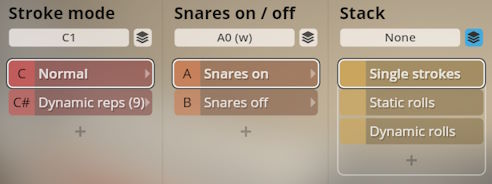
Snare on
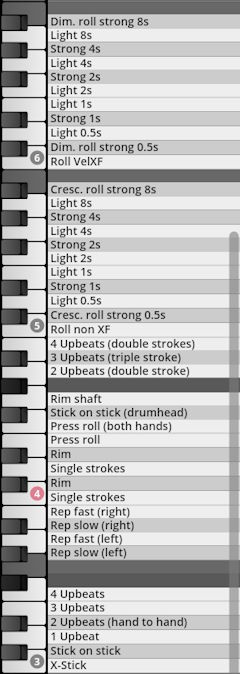
Snare off
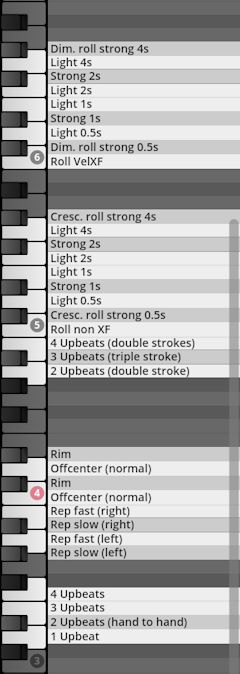
Dynamic repetitions
Medium and strong crescendo and diminuendo, slow, medium (snare on only), fast. The samples are mapped to white keys.
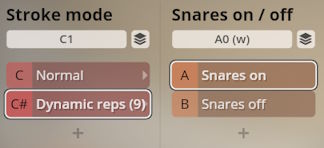
Snare on
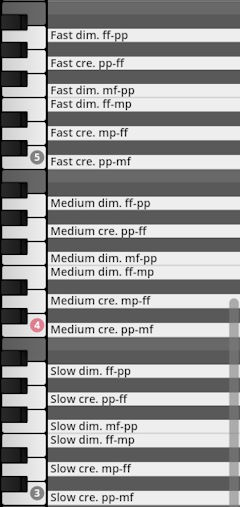
Snare off

Snare B
Snares on and off; brushes and sticks; single strokes; static rolls; dynamic rolls; dynamic repetitions.
- Beater, stroke mode: C1–D1.
- Snares on/off: A0/B0.
Sticks
Rimshots; single hits; repetitions slow and fast; press rolls; 1–4 upbeats; upbeat rolls; rolls normal and dynamics light/strong.
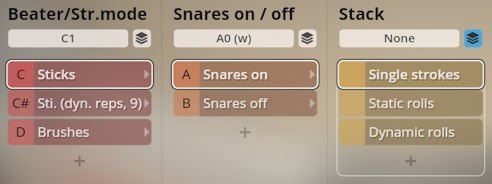
Snare on
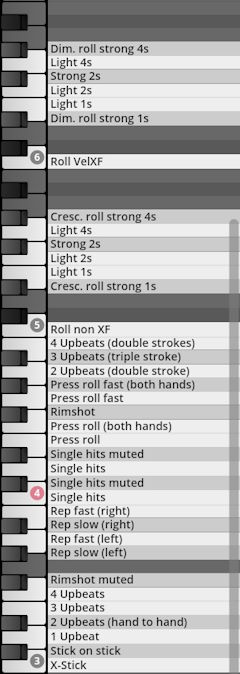
Snare off
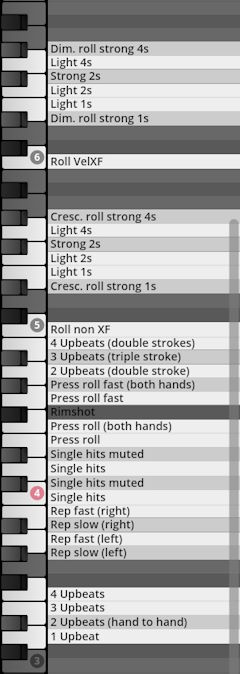
Dynamic repetitions (sticks)
Dynamic repetitions, medium and strong, slow and fast.
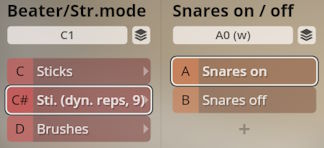
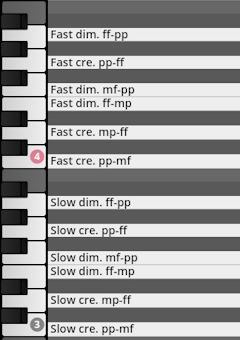
Brushes
Single strokes, normal and rim; circle; swish, 1 sec; looped swishes 1/2.
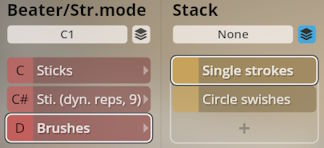
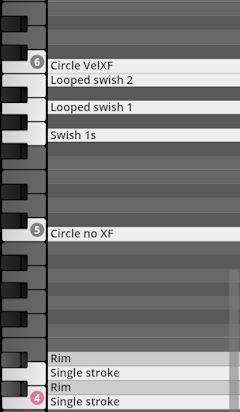
Snare drums a4
Sticks, brushes, timpani mallets; snares on and off; single strokes, rolls normal and dynamics.
- Beater, stroke mode: C1–D#1.
- Snares on/off: A0/B0.
Sticks
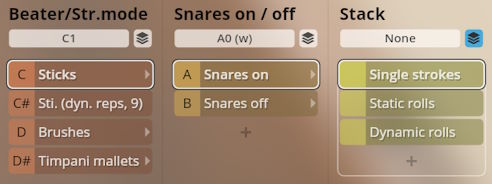
Snare on
Rimshots; single strokes; repetitions slow and fast; press rolls; 1–4 upbeats normal and rim; upbeat rolls; static and light/strong dynamic rolls, normal and rim.
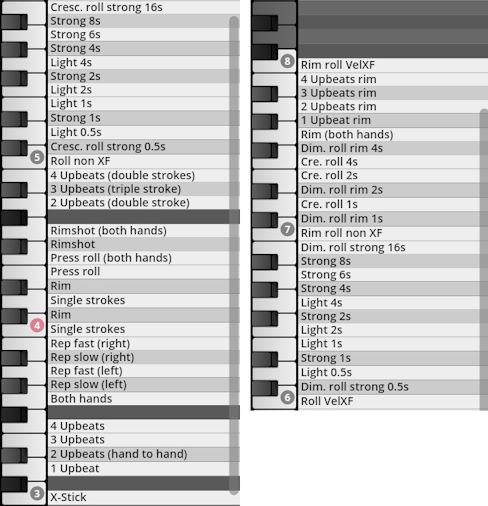
Snare off
Both hands; single strokes; rolls normal and dynamics.
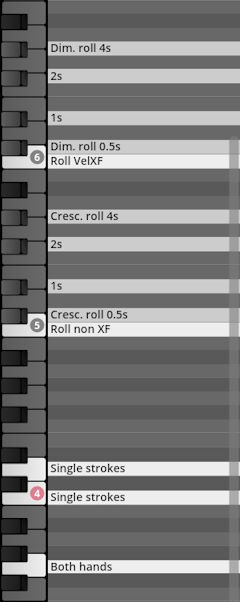
Dynamic repetitions (sticks)
Dynamic repetitions, slow and fast.
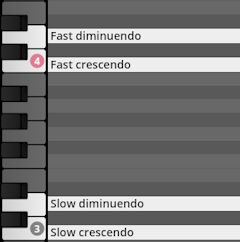
Brushes
Single strokes, circles 1/2 hands; static and dynamic rolls; swishes 1/2 hands.
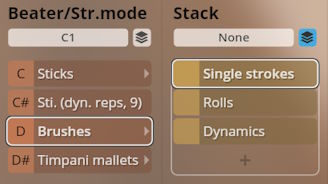
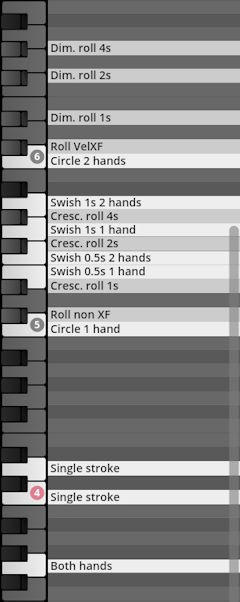
Timpani mallets
Both hands; single strokes; static and dynamic rolls.
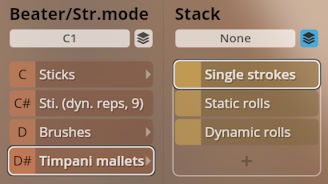
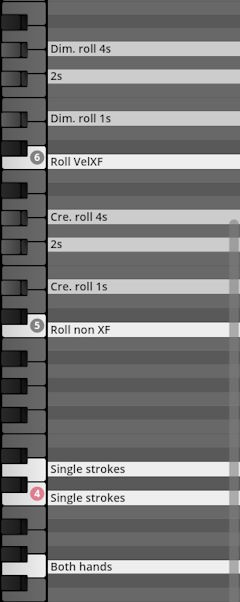
Piccolo drum
Single strokes; static rolls; dynamic rolls; dynamic repetitions.
- Stroke mode: C1–C#1.
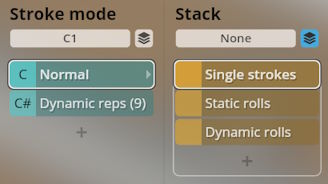
Normal
Single strokes open and muted, repetitions slow and fast, 1–4 upbeats, upbeat rolls, press rolls, rolls normal and dynamics light/strong.
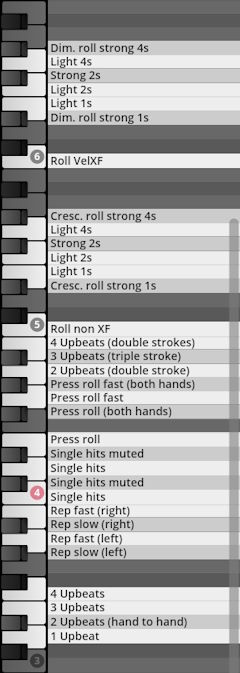
Dynamic repetitions
Dynamic repetitions, light and strong, slow and fast.
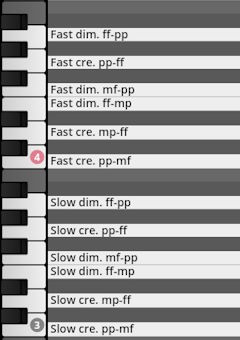
Field drum A
Sticks and mallets; snares on and off. Single strokes; rolls normal and soft; repetitions.
- Beater: C1/D1.
- Snares on/off: A0/B0.

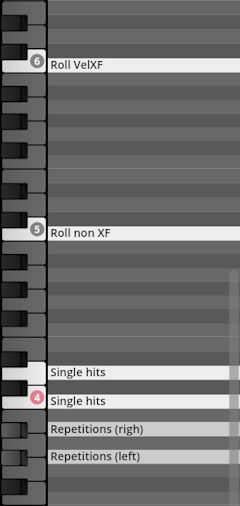
Field drum - B
Snare on; single strokes, static rolls, dynamic rolls; dynamic repetitions.
- Normal/dyn. reps: C1/C#1.
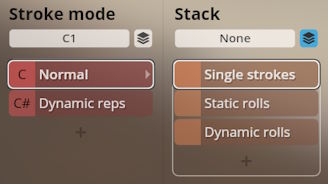
Normal
Single strokes open and muted, repetitions slow and fast; 1–4 upbeats, upbeat rolls; press rolls; static rolls; dynamic rolls light/strong.
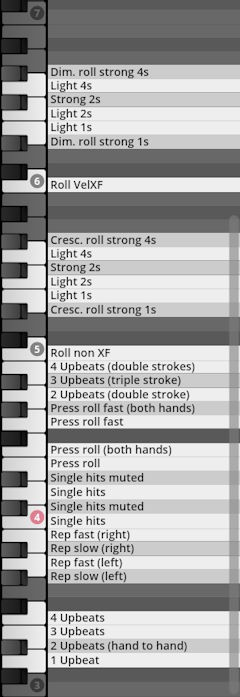
Dynamic repetitions
Dynamic repetitions, lightand strong, slow and fast.
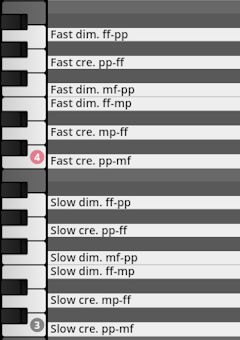
Bass drum - A
Soft and hard beaters; single strokes; static rolls; dynamic rolls; dynamic repetitions.
- Beater/stroke mode: C1–D#1
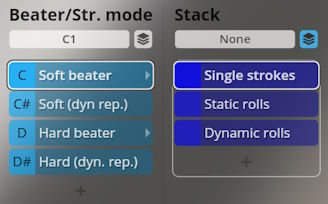
Soft / hard beater
Single hits normal/secco, repetitions slow and fast, 1–3 upbeats, rolls normal and dynamics light/strong.
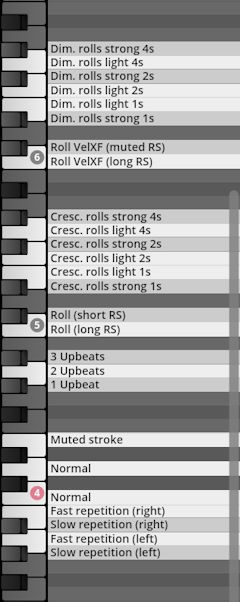
Dynamic repetitions
Dynamic repetitions, light and strong.
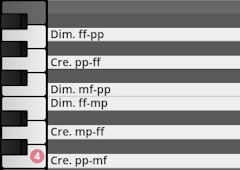
Bass drum - B
Single strokes; static rolls; dynamic rolls; dynamic repetitions.
- Normal/dyn. reps: C1/C#1.
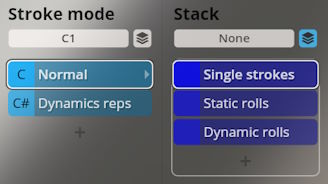
Normal
Single strokes normal and muted, side, coperto; 1–4 upbeats; repetitions slow and fast; rolls normal and dynamics light/strong.
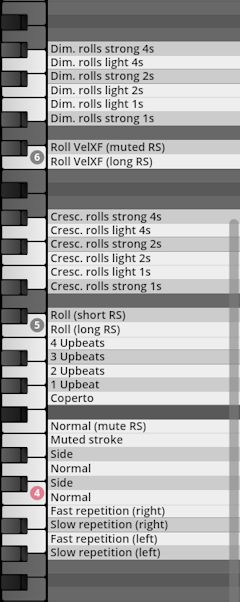
Dynamic repetitions
Dynamic repetitions, slow and fast
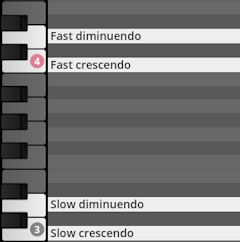
Taiko drums
- Taiko 1–7; single strokes; static rolls; dynamic rolls.
- Low Taiko: cudgel and soft beater.
The taikos offer additional "Wide" Mixer Presets where the individual taikos are placed in different positions througout the Synchron Stage, allowing you to let several instruments play over a wide space.
- Taiko selection: C2–G2.
Single taikos
Single strokes normal and rim; repetitions; rolls normal and dynamics medium/strong. The lower taikos 5 and 6 have additional static rolls with short release.
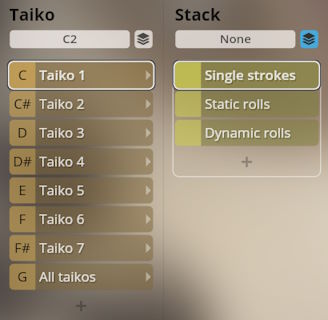
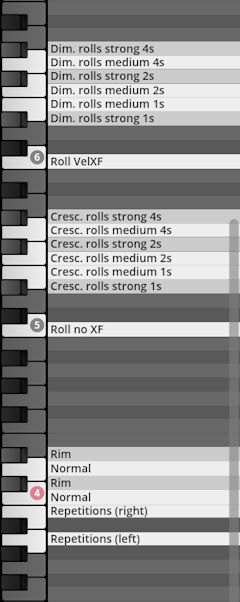
Taiko 7
Cudgel
Articulations are the same as those of taiko 5/6 above.
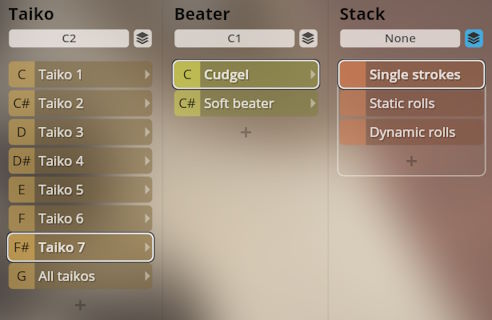
Soft beater
Single strokes, normal; static rolls with normal and short release.
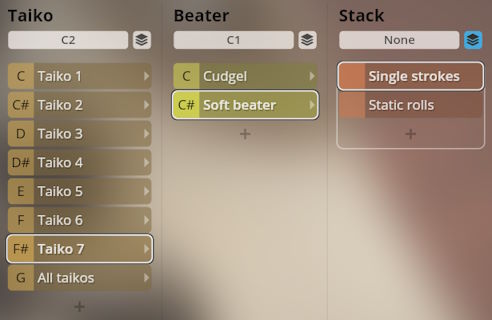
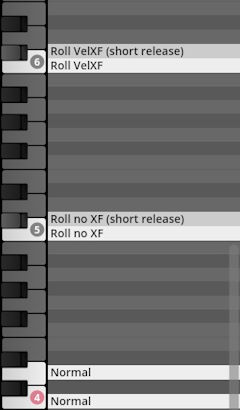
All taikos
A combination of all taikos; normal and rim hits. Mapped to white keys.
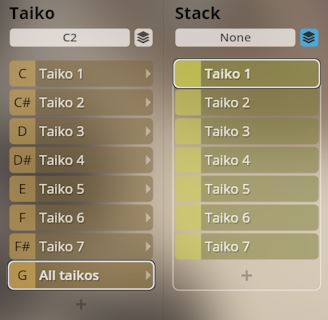
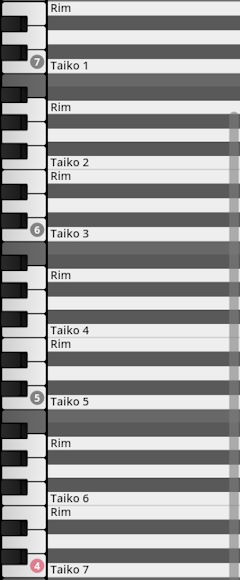
Concert toms
7 low and 6 high concert toms in various combinations. Single strokes; static rolls; dynamic rolls.
The concert toms offer additional "Wide" Mixer Presets where the individual toms are placed in different positions througout the Synchron Stage, allowing you to let several instruments play over a wide space.
- Toms selection: C1–A1.
Sets
Single hits; repetitions; rolls static and dynamic medium/strong; 1–3 upbeats.
In the sets, each tom is mapped to an octave starting from C2.
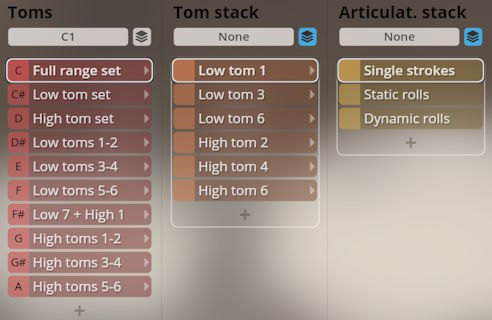
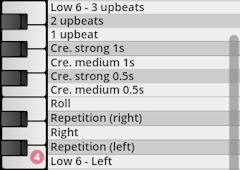
Low, high
The low and high sets provide 2 octaves for each tom, and also offer dynamic repetitions. Single hits; repetitions; rolls static and dynamic medium/strong; 1–3 upbeats; dynamic repetitions medium and strong
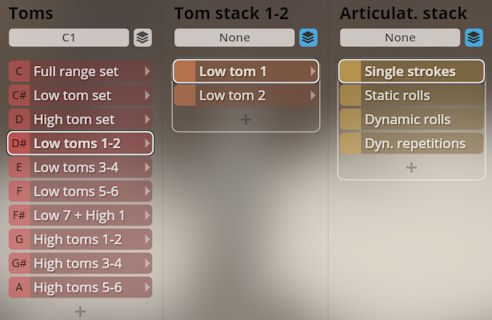
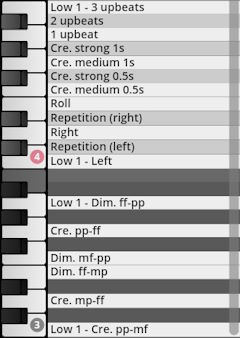
Roto toms
Roto toms 1–5; sticks and mallets.
- Mapping: D3–C5/D5–C7 left/right hand, cres/dim, etc.
- Beaters: C1/D1.
Sticks
Single hits; rim hits; static rolls; performance repetitions; dynamic rolls light and strong, 1/2 sec.
- Articulations: F1–C2.
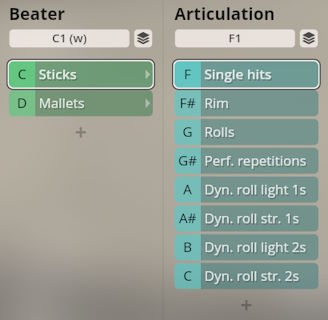
Mallets
Single hits; rim hits; static rolls; performance repetitions.
- Articulations: F1–G#1.
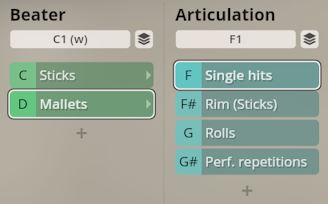
Tambourines
Tambourines A/B/C/D. Single strokes; static rolls; dynamic rolls; dynamic repetitions (A only).
- Tambourines: C2–D2.
Tambourine A
Single strokes center and rim; repetitions slow and fast; 1–3 upbeats; static rolls, thumb and shake; crescendo rolls, 2/4 sec.
- Stroke mode: C1–C#1
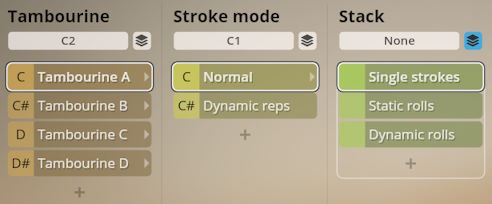
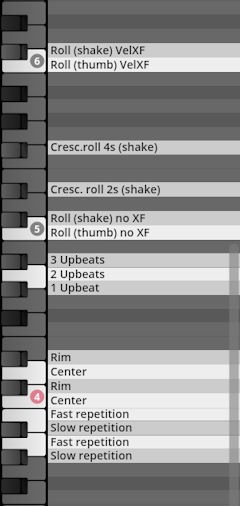
Dynamic repetitions
Dynamic repetitions, light and strong, slow and fast.
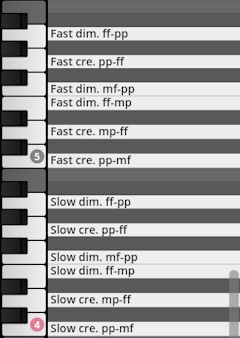
Tambourine B / C / D
Single hits normal and sforzato; 1–4 upbeats, normal and loose; shakes and thumb tremolo; dynamic rolls, shake and thumb.
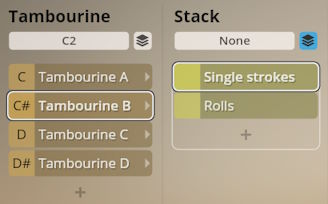
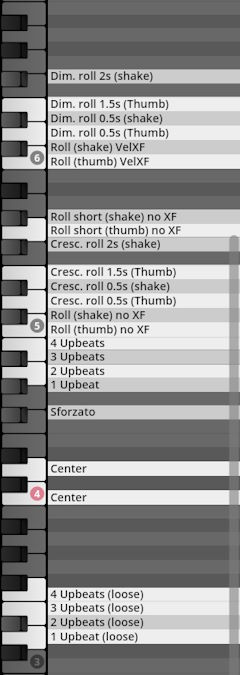
Boobams
Single hits; rim hits; rolls and press rolls slow and fast; 1–4 upbeats loose and tight.
- Range: A#2–D6.
- Beater: C1–C#1.
- Articulation: F1–C2.
- Speed switch: A0/B0.
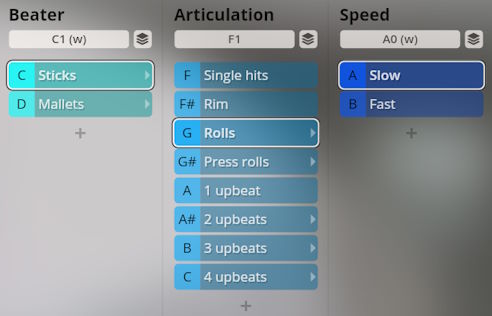
Drums processed
Concert toms, snare drum, bass drum, tambourine. Single strokes dry and wet; rolls dry and wet.
Use Dim.Ctrl/A (MIDI CC3) to adjust the amount of dry/wet signal.
- Dry /wet amount: Dim.Ctrl/A (MIDI CC3).
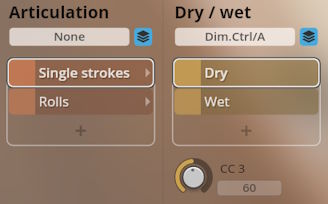
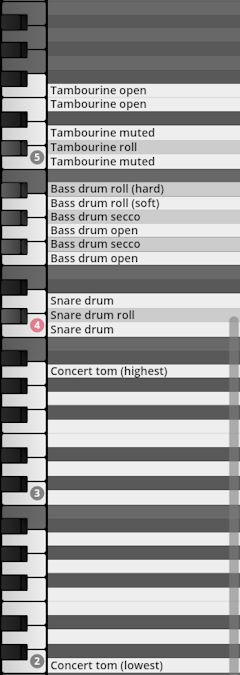
Cymbals & Gongs
Nowadays the orchestral cymbal family consists of the pair (piatti), the suspended cymbal and the small antique cymbals.
The pair of cymbals is used especially to accentuate musical climaxes and from the Romantic period it has played an important role in the orchestra. Its powerful sound can rise above the entire orchestra. It is sounded by striking one plate against the other.
Suspended cymbals are struck with a stick or mallet. In the orchestra the standard instrument is the Turkish cymbal, which is used especially to create tension. The Chinese cymbal was introduced to the orchestra in the 20th Century due to its exotic sound.
The gong is the metal percussion instrument that provides melodies and an exotic flavor in that section. The gong is often confused with the tam-tam, but there is a number of significant differences between the construction and the sound of the two instruments: unlike the tam-tam the gong has a definite pitch. Apart from that the tam-tam is a relatively flat disc, whereas the gong has a knob in the center.
- Instruments
- Piatti
- Suspended cymbals
- Finger cymbals
- Tam-tams
- Gongs
- China gongs
- Cymbals processed
Piatti
Piatti A, 11" Chinese cymbal, 13" and 15" Zildjian Avedis, 16" Zildjian K1, 16" Zildjian K2, Zildjian Avedis, 18" Istanbul Janissary, 20" Istanbul Symphonic, 20" and 22" Zildijan Avedis.
Single strokes, normal and loose (piatti A); muted fast and slow; sizzle strokes (from 16" K2).
- Instruments: C2–A2.
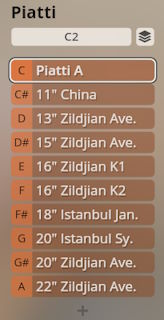
Piatti A
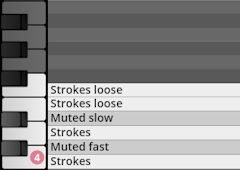
11" Chinese cymbal, 13" and 15" Zildjian Avedis, 16" Zildjian K1
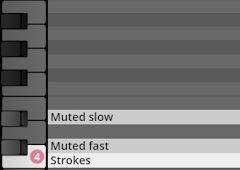
16" Zildjian K2, Zildjian Avedis, 18" Istanbul Janissary, 20" Istanbul Symphonic, 20" and 22" Zildijan Avedis
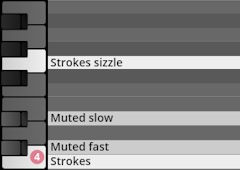
Suspended Cymbals
Cymbal A / B / C / D, crash 15 and 16", China 18 and 22", ride 20 and 22", splash 6, 8, 12". Various beaters according to instrument; single strokes; static rolls; dynamic rolls.
- Instruments: C2–C3.
- Beaters: starting from C1.
Cymbal A
Sticks, mallets; single strokes, ringing and muted; static rolls; dynamic rolls, medium and strong.
Timpani mallet: single strokes, ringing.
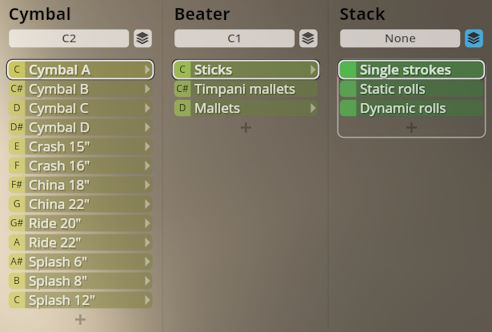
Sticks
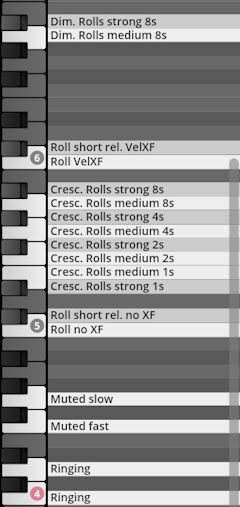
Timpani mallet
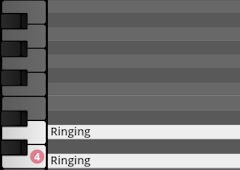
Cymbal B / C / D
Drumsticks, wool mallets, brushes (except cymbal C), metal beater; single hits, ringing and muted; static rolls; dynamic rolls, medium and strong.
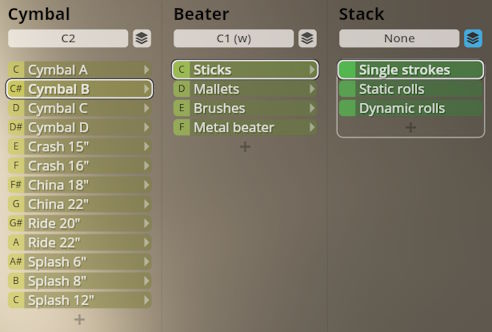
Sticks
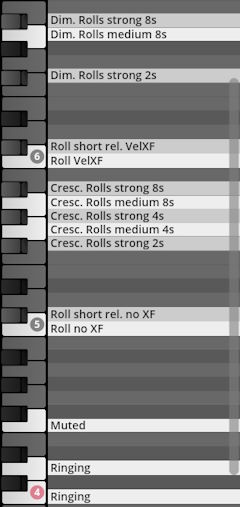
Mallets, brushes
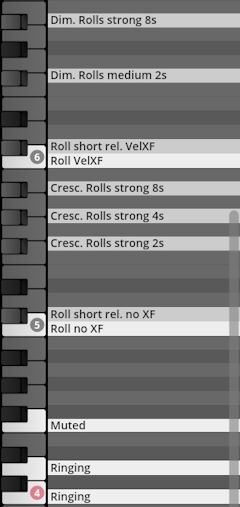
Metal beater
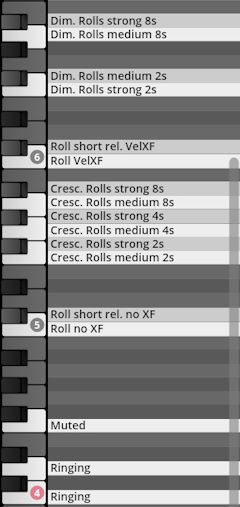
Crash 15", crash 16"
Sticks, timpani mallets, mallets, rods, brushes, bow; bell, top, and edge hits, ringing and muted; scrapes (rods, brushes); bowed, 4/6 variants. Articulations vary according to beater.
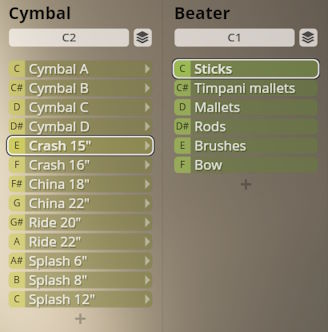
Sticks
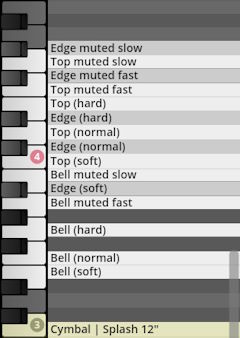
Metal rods, 15” crash
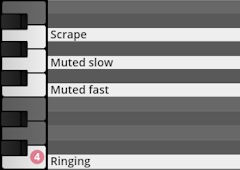
Metal rods, 16” rods
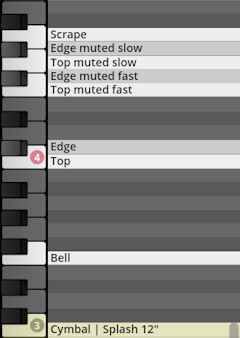
Brushes

Bow
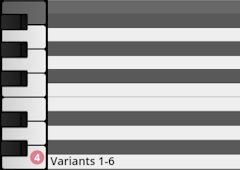
China 18", China 22"
Sticks, timpani mallets, mallets, rods, brushes, bow; edge and top hits, normal and muted, hard and soft; scrapes (rods, brushes); bowed, 4/5 variants.
Sticks, timpani mallets, mallets
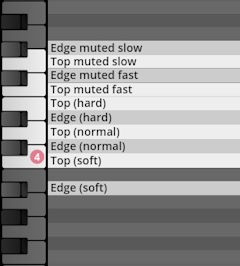
Rods
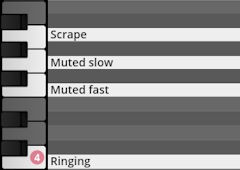
Brushes
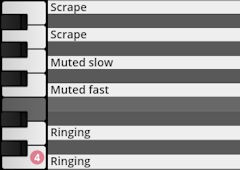
Ride 20", ride 22"
Sticks, timpani mallets, mallets, rods, brushes, bow; Bell, edge, and top hits, normal and muted, hard and soft; scrapes (rods, brushes); bowed, 4/8 variants.
Sticks etc.
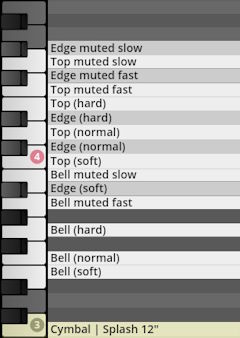
Rods, 20”
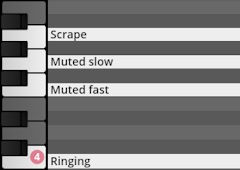
Rods, 22”
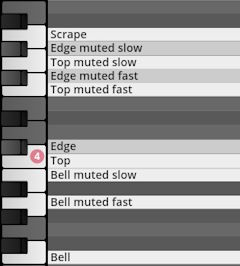
Brushes, 22”
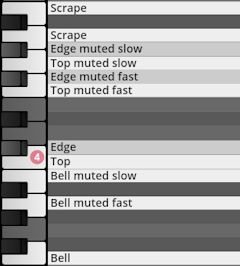
Splash 6", splash 8", splash 12"
Sticks, timpani mallets, mallets, rods, brushes, bow; normal, hard, and soft hits, ringing and muted; bowed, 5/6 variants.
Bow variants are mapped to white keys from C4.
Sticks, mallets, 6”
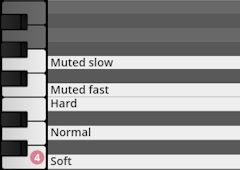
Rods, brushes, 6”
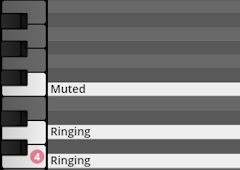
Sticks, mallets, 8”
Edge hits: sticks only.
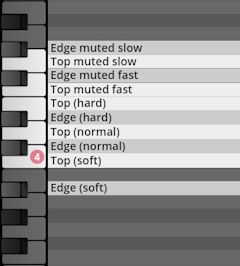
Rods, brushes, 8”
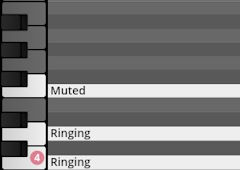
Sticks, mallets, 12”
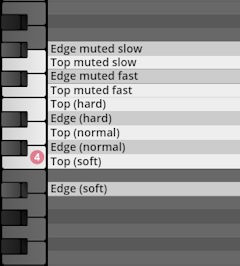
Rods, 12”
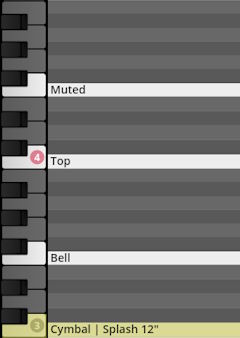
Finger cymbals
High and low finger cymbals; open stroke, clash, slide.

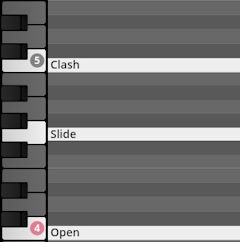
Tam-tams
Tam-tam A
Series B, 25/60/85/100/110/130 cm
Series C, 30/40/50/60/70/80/90 cm.
- Instruments: A1–A#2
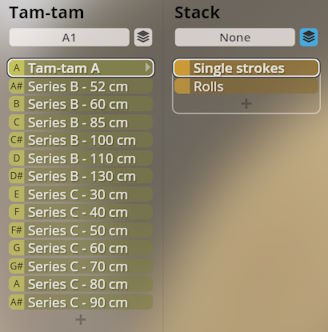
Tam A
Single strokes with tam and metal beaters; rolls, long and short release; scratches
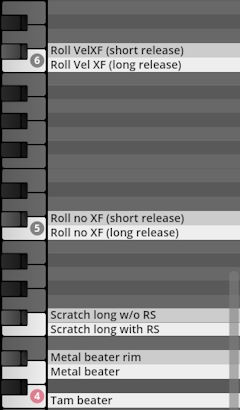
Series B, 25/60/85/100/110/130 cm
Tam and metal beaters, superball (85–130 cm); single hits; scratches
52–60 cm
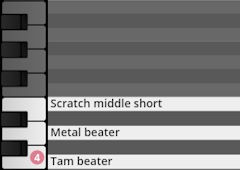
85–130 cm
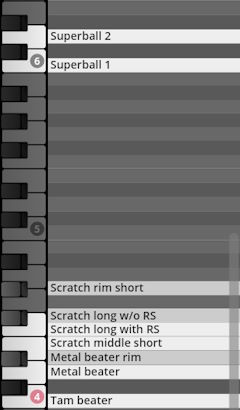
Series C, 30/40/50/60/70/80/90 cm
- 30–60cm: tam beater, single stroke, surround hits.
- 70–90 cm: tam and metal beaters, brushes; single hits; scratches; brush circles.
30–60 cm

70–90 cm

Gongs
Soft, wood, and metal beaters, bow; single strokes; static rolls, normal and short release; crescendo rolls.
Metal beater: single strokes.
Bow: variant 1/2.
Ranges
- Single strokes: soft C2–A5
- others A2–A5.
Beater: C1–D#1.
Articulation: starting from F1.
Normal/short release: A0/B0 (soft beater only).
Soft and wood mallets
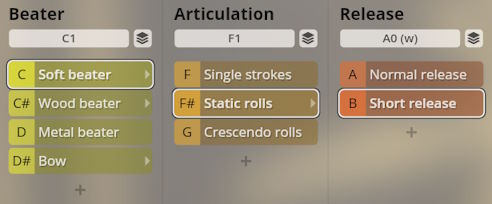
Bowed
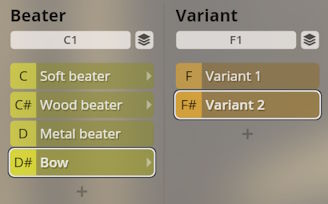
China gongs
China gongs and Peking opera gongs.
- Instrument: C2/C#2
- Articulation: China F1–G1; Peking opera F1/G1.
China gongs
Single strokes, normal and short release; static rolls, normal and short release; crescendo rolls.
- Range: C4–A4, white keys.
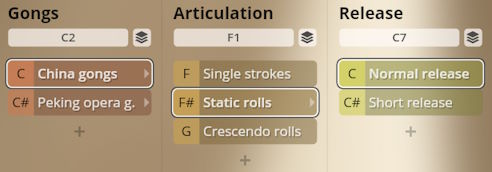
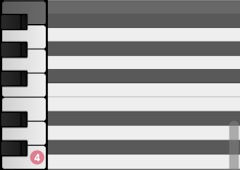
Peking opera gongs
Single strokes; crescendo rolls, 1/2/6 sec.
- Range: C4–G4, white keys.
- Rolls duration: C7–D7.
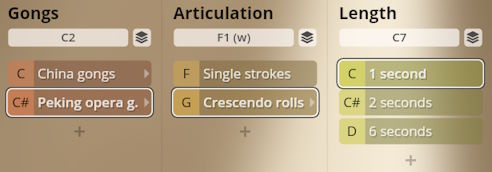
Cymbals processed
Cymbal, piatti, tam-tam; single strokes dry and wet; rolls dry and wet (cymbal). Use Dim.Ctrl/A (MIDI CC3) to adjust the amount of dry/wet signal.
- Dry /wet amount: Dim.Ctrl/A (MIDI CC3).
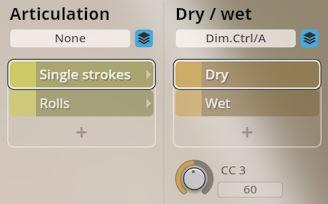

Mallets
The mallets are the melody instruments in the percussion group. The tasks performed by the mallet instruments in the orchestra are determined by their sound characteristics and are consequently many and varied.
- Instruments
- Celesta
- Glockenspiel A and B
- Xylophone
- Vibraphone
- Marimba
- Crotales
- Temple blocks
- Lithophone
- Stir xylophone
- High mallets processed
88 keys/loco switch (where applicable): A0/B0.
Celesta
Single notes, regular and with soft attack
Staccato
Glissandos
Loco and transposed mappings.
Range:
- transposed C2–F7
- loco C3–F8
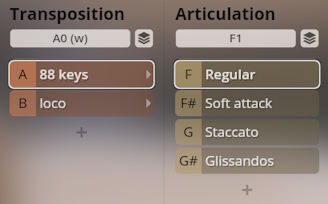
Glissandos
Glissandos, diatonic and pentatonic, slow and fast, up and down.
- Range: C3–G#7.
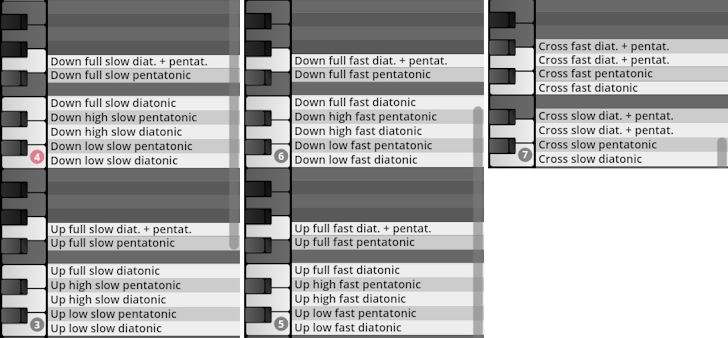
Glockenspiel A
- Metal, plastic, and wood beaters, big metal beater.
- Single strokes, regular and with vibrato
- Static rolls
- Crescendo rolls (except wood)
- Glissandos (except wood).
- Metal beater: rolls regular and chords
- Loco and transposed mappings.
- Range
- transposed F4–D7
- loco F5–D8
- Beater: C1–D#1.
- Articulation: F1–G#1
- Type, glissando direction: C2–C#2

Glissandos, metal and big metal beater
Glissandos, diatonic and chromatic, octave, cross (4/3 variants), and full range.
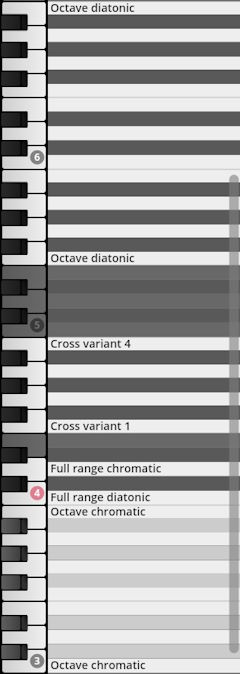
Glissandos, plastic beater
Glissandos, diatonic, octave and cross (5 variants); full range, diatonic and chromatic.
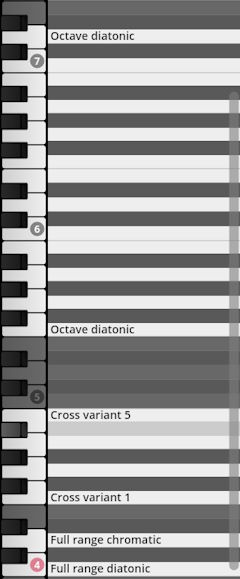
Glockenspiel B
- Metal, plastic, and wood beaters
- Single notes
- Rolls
- Glissandos (metal beater)
- Loco and transposed mappings.
- Range
- transposed F4–C7
- loco F5–C8.
- Beater: C1–D1.
- Articulation
- metal beater F1–G#1
- others F1/F#1

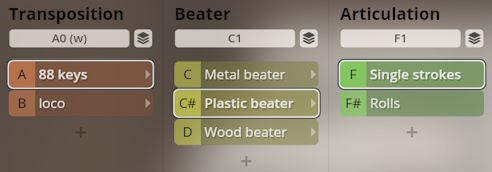
Glissandos
Metal beater: glissandos up and down, slow and fast; octave diatonic; cross (fast only); full range chromatic, diatonic, pentatonic (fast only).
- Up/down: C2–C#2.
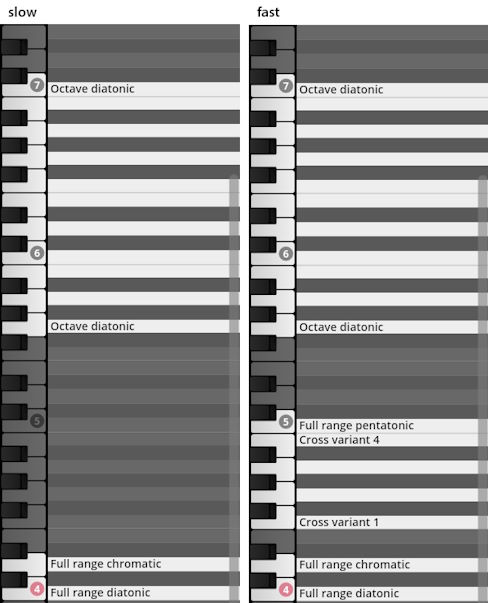
Xylophone
- Wood beater, hard, medium, soft plastic beaters, yarn beater
- Single notes, regular and cluster
- Static rolls, regular, chords, and cluster
- Dynamic rolls, 0.5/1/3 sec. (wood beater)
- Glissandos.
- Yarn beater: single strokes and static rolls only.
- Range: F4–C8.
- Beater: C1–E1.
- Articulation: F1–A#1, yarn beater F1/F#1.
- Single strokes regular/cluster: C2/D2.
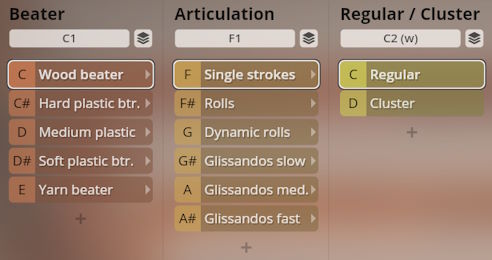
Rolls
- Regular/chords/cluster: C2–D2.
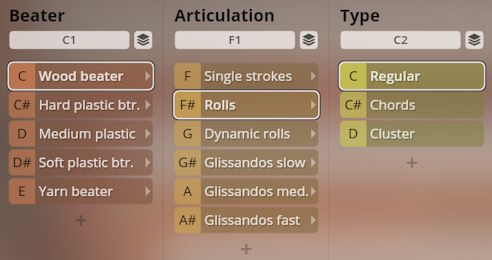
Dynamic rolls
Wood beater only: dynamic rolls, 0.5/1/3 sec.
- Duration: C2–D2.
- Cresc/dim: A0/B0.
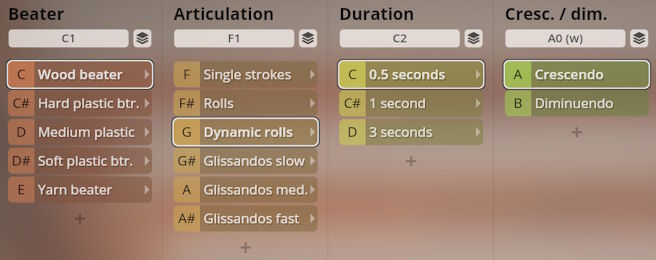
Glissandos
Octave glissandos slow, medium, fast, up and down, diatonic; medium and fast full range glissandos, diatonic and chromatic; medium and fast cross glissandos, 2 variants.
- Up/down: C2/D2.
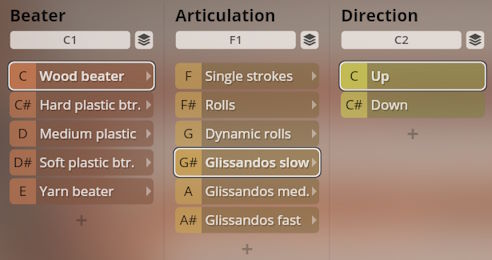

Vibraphone
- Medium, soft, hard mallets, bow
- Single strokes open, motor off/slow/fast, normal and short release
- Single strokes secco
- Rolls normal and chords
- Dynamic rolls, 2/4 sec.
- Glissandos slow and fast, diatonic and chromatic, up and down (medium mallets).
- Hard mallets: open and secco only.
- Bow: long and short, motor off/fast.
- Range: E3–G6.
- Beater: C1–D#1.
- Articulation: starting from F1.
- Motor off/slow/fast: A0–B0.
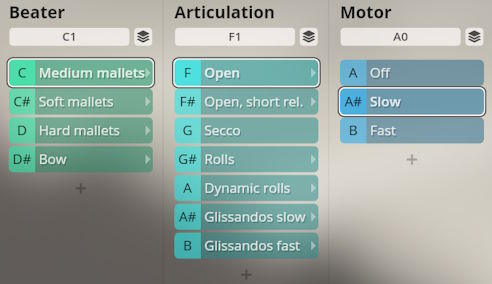
Rolls
Static rolls, normal and chords.
- Normal/chords: A0/B0.

Dynamic rolls
- Dynamic rolls, 2/4 sec.
- Duration: C2/C#2.
- Cresc/dim: A0/B0.
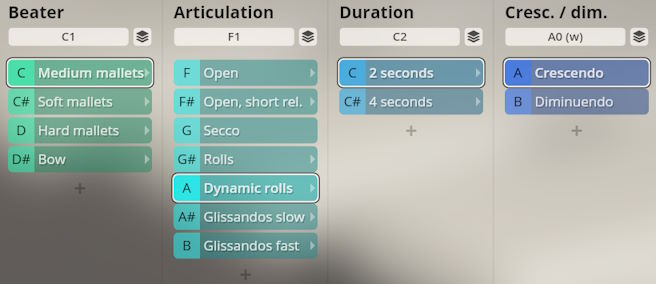
Glissandos
- Up/down: A0/B0.
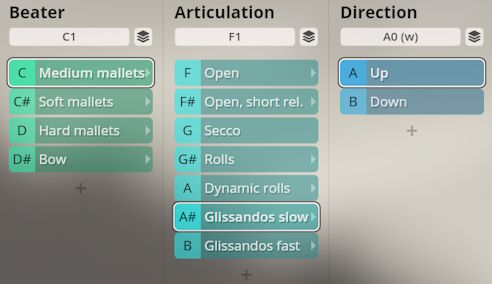
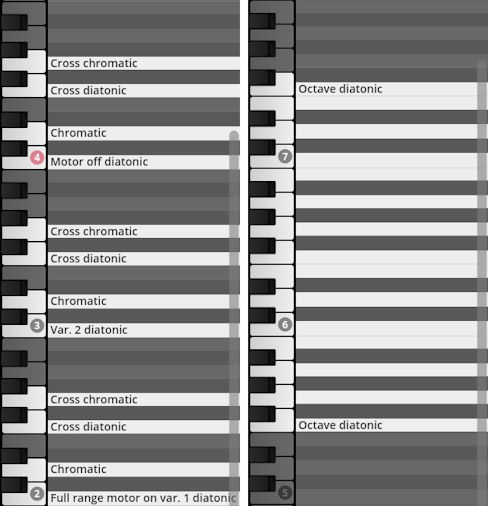
Bow
Long and short notes, motor off/fast.
- Motor off/fast: A0/B0
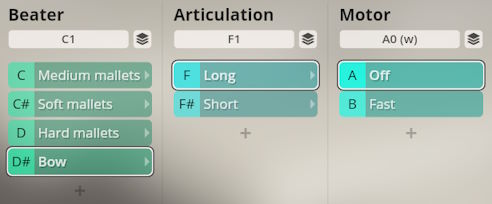
Marimba
- Hard and soft mallets, bow, special beaters, additional mallets
- Single strokes, open, secco, handle
- Rolls normal and chords
- Dynamic rolls 1/2/4 sec.
- Glissandos slow and fast, diatonic and pentatonic, up, down, cross.
- Special beaters: superball, rubber mallets, finger, fingernail.
- Additional mallets: very hard, very soft, supersoft.
- Range: C2–C7; additional mallets according to beater.
- Mallets: C1–E1.
Mallets
Articulation: F1–B1.
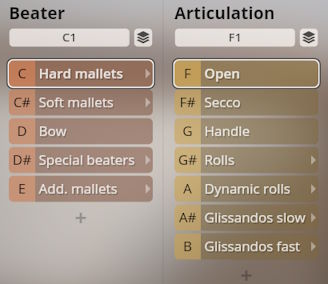
Rolls
Static rolls, normal and chords.
- Normal/chords: A0/B0.
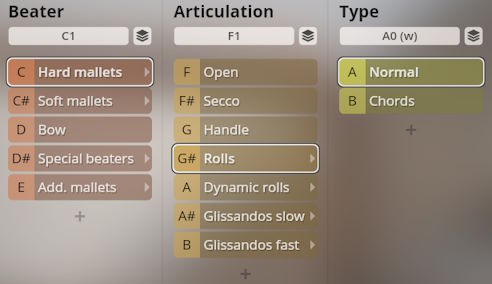
Dynamic rolls
Dynamic rolls, 1/2/4 sec.
- Duration: C2–D2.
- Cres/dim: A0/B0.
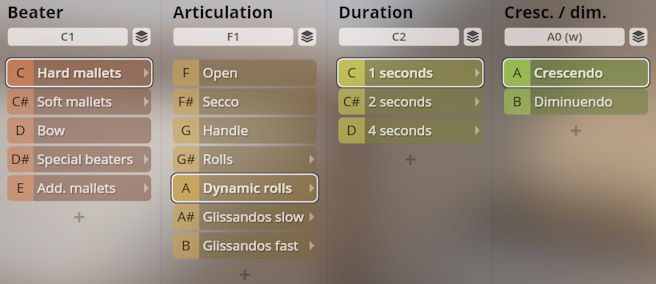
Glissandos
Glissandos slow and fast, low, middle, high range; diatonic and pentatonic, regular and cross.
- Up/down: A0/B0.
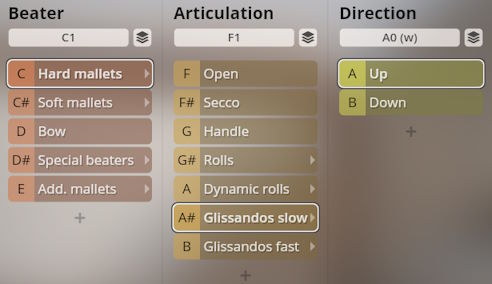
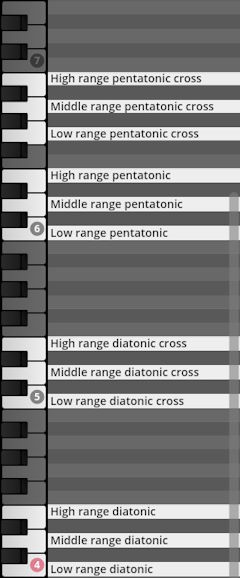
Beaters
Superball, rubber, finger, and fingernail: single strokes.
- Range: C2–C7; superball C2–D6.
- Beater: F1–G#1.
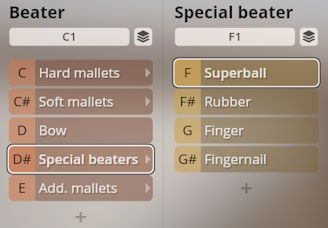
Additional mallets
Very hard, very soft, supersoft mallets
Single strokes, open
Rolls.
Supersoft: single strokes secco.
Range
- very hard A#2–C7
- very soft C2–C6
- rolls C2–D4
- supersoft C2–A4
- rolls C2–D4
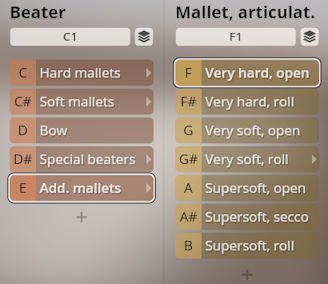
Crotales
- Metal mallet, triangle beater, bow
- Single notes
- Loco and transposed mappings.
- Range: transposed A#4–F#7, loco A#5–F#8.
- Beater: C1–D1.
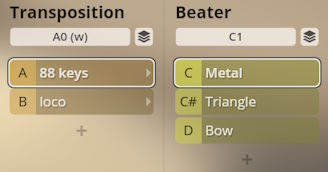
Temple blocks
- Wood, yarn, soft yarn, rubber mallets
- Single strokes
- Rolls
- Dynamic rolls, 1/2/4 sec., accelerando and ritardando
- 1–3 upbeats
- Glissandos, slow and fast, up and down
- Soft yarn, rubber: single strokes only.
- Range
- single strokes A#2–G4 left hand, A#4–G6 right hand
- dynamic rolls A#2–G4 crescendo/accelerando, A#4–G6 diminuendo/ritardando
- rolls, upbeats A#2–G4 Beater: C1–D#1. Articulation: F1–B1. Dynamic rolls duration: C2–D#2.
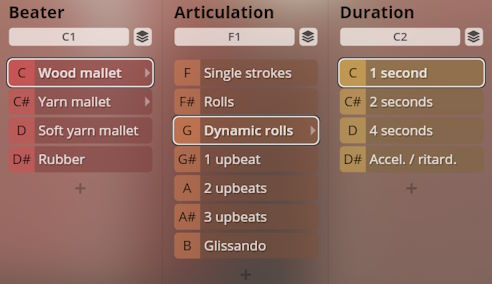
Glissando
Glissandos up and down, slow and fast.
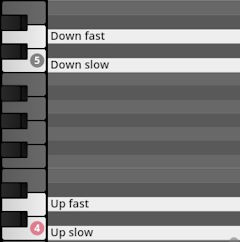
Lithophone
- Single strokes
- Rolls
- Rubbed
- 1–4 upbeats.
- Range: G5–D7; single strokes G3–D5 left hand, G5–D7 right hand.
- Articulation: F1–B1.
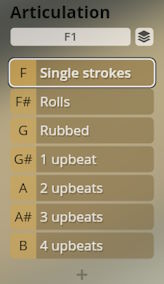
Stir xylopohone
- Small, medium, large stir xylophone
- Single notes
- Glissandos, up and down, slow/fast/medium, accelerando slow/fast.
- Single notes: small and medium C6–C7; large C5–C7.
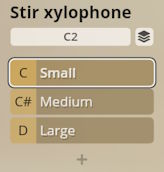


High mallets processed
- Celesta, glockenspiel, xylophone; single notes, dry and wet.
- Loco and transposed mappings. Use Dim.Ctrl/A (MIDI CC3) to adjust the amount of dry/wet signal.
- Range: according to instrument.
- 88 keys/loco: A0/B0.
- Instrument: C1–E1 (white keys).
- Dry /wet amount: Dim.Ctrl/A (MIDI CC3)
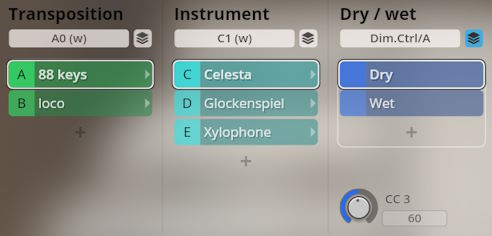
Bells
Various types of bell and bell substitutes that have been used in the orchestra over the centuries.
Today mainly two instruments have become part of standard instrumentation in the modern opera and symphony orchestra: tubular bells and plate bells.
Their main role was to act as a substitute for church bells in the orchestra. Tubular bells were developed as an easily portable instrument for everyday use in the orchestra. Their sound was intended to be as close as possible to church bells, a target that they never reached, however. Nowadays their timbre is valued in its own right. They are used in the higher register, while the lower register is covered by the bell plates.
For special effects cow bells, altar-boy bells, sleigh bells and other bells are occasionally called for.
- Instruments
- Tubular bells A / B
- Plate bells
- Hand bells
- Cencerros
- Japanese singing bowls
- Church bells
- Burma bells
- Jingle bells
- Bell tree
- Ship's bell
- Altar-boy bells
- Finger bell
- Tubular bell processed
Tubular bells A
Philharmonic tubular bells.
- Medium, hard, soft hammer
- Single strokes
- Static rolls, normal and short release (hard hammer)
- Crescendo rolls
- Medium hammer: single strokes only.
- Range: G5–D7; single strokes G3–D5 left hand, G5–D7 right hand.
- Beater: C1–D
- Articulation: F1–G1.
- Release normal/short: A0/B0.
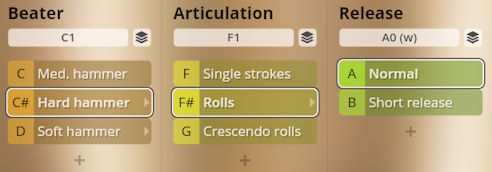
Tubular bells B
Deagen tubular bells.
- Medium, hard, soft hammers, brushes, effects
- Single strokes
- Rolls, normal and short release.
- Brushes: rolls only.
- Effects: glissandos, cluster.
- Range: E3–D5.
- Beater: C1–E
- Articulation: F1–F#1.
- Release normal/short: A0/B0.
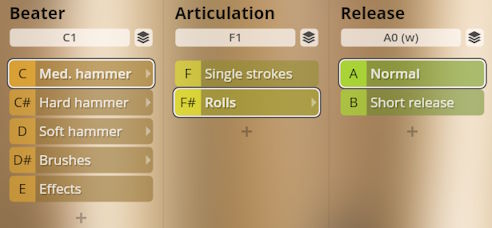
Effects
Glissando up and down, slow and fast; cluster.
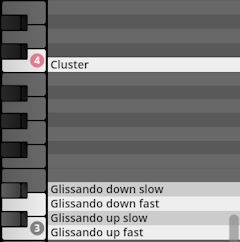
Plate bells
Single notes.
- Range: A#2–D5
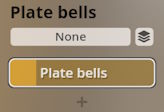
Hand bells
Metal beater, triangle beater, bow
- Single notes
- Range: D5–F7.
- Beater: C1–D1.
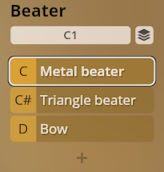
Cencerros
Soft, medium, hard yarn mallets; soft and hard felt mallets, metal and wood beaters; bow; rasping stick
- Single note
- Rasping stick: slow and fast.
- Range: D3–D7; soft yarn, felt: D3–D5.
- Beater: C1–E1.
- Type: yarn F1–G1; felt and hard beaters F1/G1
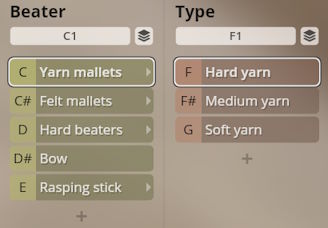
Rasping stick
Slow/fast: A0/B0.
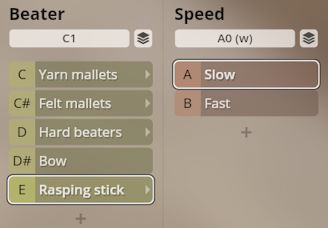
Japanese singing bowls
Rubber and wood beaters
- Single notes, open and secco.
- Range: B4–D6.
- Beater: C1/C#1.
- Open/secco: A0/B0.
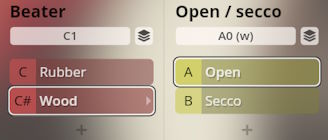
Church bells
Wood and metal beaters
- Single notes.
- Range: E4–E6.
- Beater: C1/C#1.
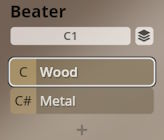
Burma bells
2 Burma Bells
- Yarn, wood, metal beaters
- Single notes
- Range: C5–F6.
- Beater: C1–D1.
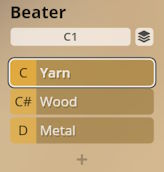
Jingle bells
Low, medium, high jingle bells
- Single shakes
- Rolls normal and short/fast
- Slow and fast repetitions
- Beater: C1–D1.
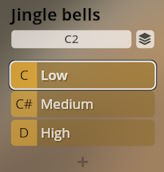
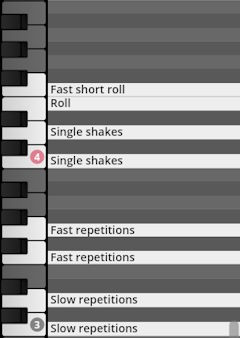
Bell tree
Metal and triangle beaters
- Strokes and glissandos, up and down, slow and fast, variations according to beater.
- Beater: C1/C#1.

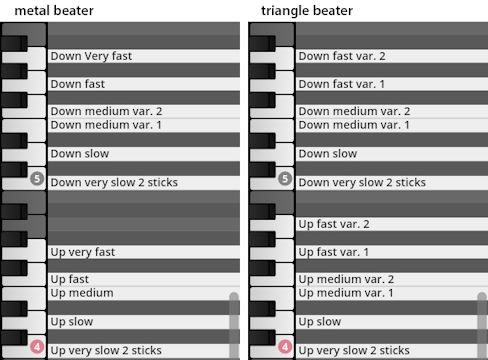
Ship’s bell
Short, 3 variants
Long.
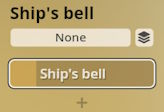

Altar-boy bells
Low and high bells
- Single strokes
- Short (2 variants) and long ringing.
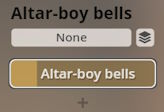
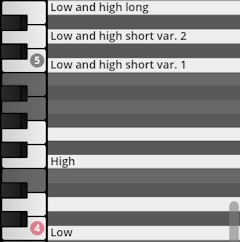
Finger bell
Single strokes, 3 variations with different vibrato.
- Mapping: C4–E4 (white keys).
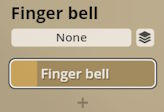
Tubular bells processed
Single notes, dry and wet. Use Dim.Ctrl/A (MIDI CC3) to adjust the amount of dry/wet signal.
- Range: C3–A5.
- Dry /wet amount: Dim.Ctrl/A (MIDI CC3)
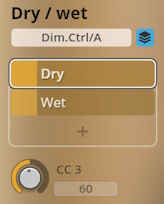
Orchestral Percussion
- Instrument
- 06a Orchestral Percussion
- Triangles
- Woodblocks
- Castanets
- Log drum
- Stell
- Slapsticks (Whips)
- Hammer
- Percussion processed
- 06b Latin Percussion
- Bongos
- Cowbells
- Guiros
- Claves
- Wind chimes
- Shaker
- Caxixis
- Rainmaker
- Cuicas
- 06c Effect Percussion
- Wind machine
- Thundersheets
- Ocean drums
- Gun shots
- Waterphone
- Jingle rings
- Ratchets
- Sirens
- Bull roarer
- Spring drum
- 06a Orchestral Percussion
Triangles
Triangle A, B, C, D.
- Instrument: C2–D#2
Triangle A, B
Single strokes, top and side, normal and muted
- repetitions, normal and dynamics
- 1–3 upbeats
- Static rolls, normal and short release
- Dynamic rolls, 1/2/4/8 sec.
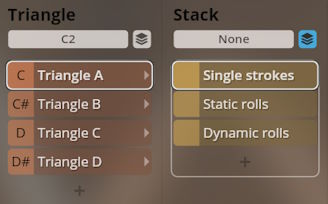
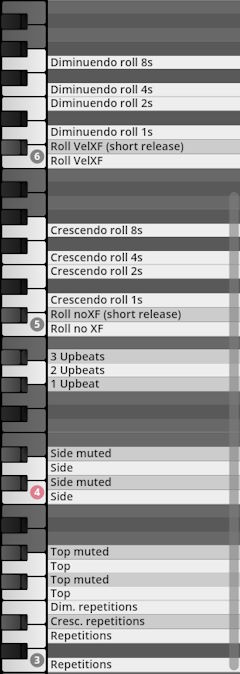
Triangle C, D
Thick and thin metal, plastic, wood beaters: single strokes.
Thick metal only: static rolls; dynamic rolls; 1–4 upbeats.
- Beater: C1–D#1.
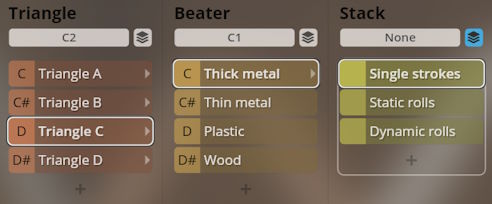
Thick metal
Single strokes top and side; vibrato; 1–4 upbeats, slow/fast; stattic rolls, normal and short release; dynamic rolls, medium and strong, 1/2/4 sec.
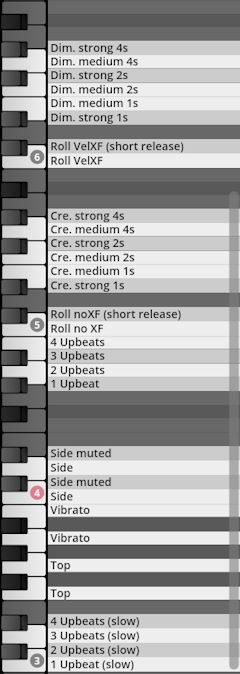
Thin metal
Single strokes top and side; vibrato; closed.
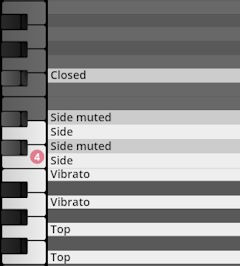
Plastic and wood
Single strokes (triangle D: top and side) open and muted; vibrato.
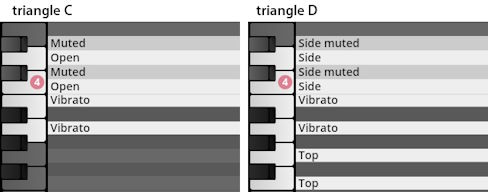
Woodblocks
- Woodblock 1–5
- Yarn, wood, rubber, soft yarn mallets
- Single strokes
- Static rolls, normal and accelerando/ritardando
- Dynamic rolls, 1/2/4 sec.
- 1–4 upbeats.
- Mapping: each woodblock is mapped to one octave, starting at C2.
- Beater: C1–D#1.
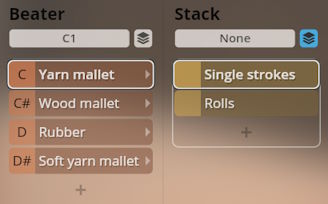
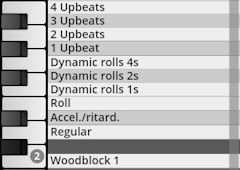
Castanets
Single hits, right and left
- Rolls short and long
- Repetitions right/left, regular and with accent
- 1–4 upbeats
- 4 upbeats, fast
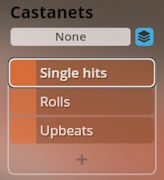
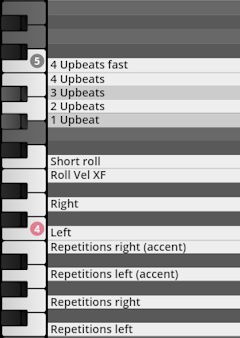
Log drum
Soft, medium, hard, wood beaters
- Single notes
- Rolls (without and with velocity crossfading)
- Mapping: single notes F#2–G#3; rolls no XF F#4–G#5; rolls velXF F#6–G#7.
- Beater: C1–D#1.
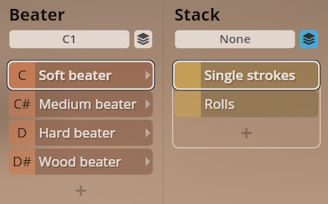
Steel
- Rails 1–6
- Brakes 1–8
- Springs 1–2.
- Steel type: C1–D1.
Rails
Rails 1–6: single strokes; rolls normal and crescendo; 1–3 upbeats.
The rails offer additional "Wide" Mixer Presets where the individual rails are placed in different positions througout the Synchron Stage, allowing you to let the instruments play over a wide space.
Mapping: each rail is mapped to an octave, starting from C2.
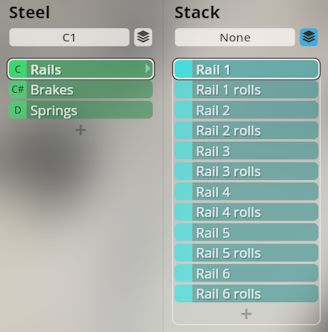
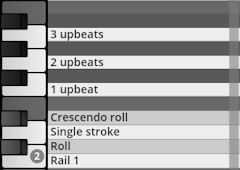
Brakes
Disc 1 and 2: single strokes.
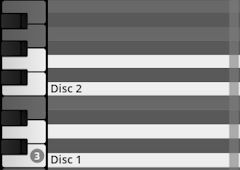
Springs
Spring 1 and 2: single hits; glissando slow and fast.
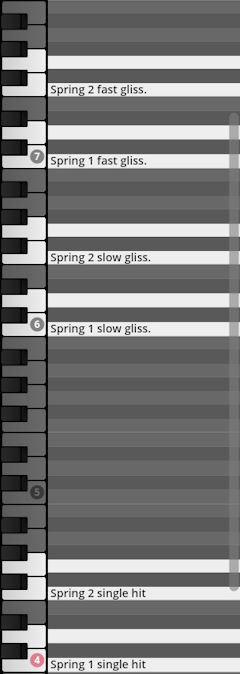
Slapsticks (Whips)
Slapstick 1 and 2, single and stacked
- 2 sound variations.
- Slapsticks: C1–D1.
- Mapping: all slapsticks: stick 1 C4/D4, stick 2 C5/D5;
- single slapsticks: C4/D4
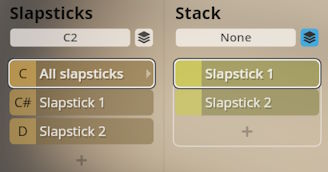
Hammer
Hammer beats on wood blocks, boards, and crates.
- Mapping: blocks C3/G#3, boards C4/F4; crates C5/E5
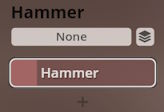
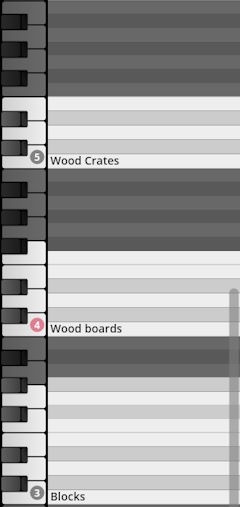
Percussion processed
Triangle, rails 1–4, slapsticks, hammer
- Single strokes, dry and wet.
- Triangle: roll, dry and wet. Use Dim.Ctrl/A (MIDI CC3) to adjust the amount of dry/wet signal.
- Dry /wet amount: Dim.Ctrl/A (MIDI CC3)
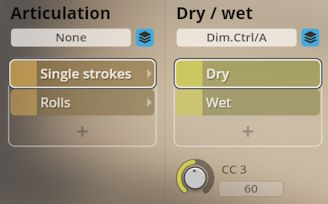
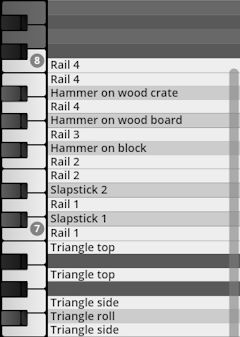
Bongos
Low and high bongos
- Single strokes, open and muffled
- Static rolls, loose and tight
- Dynamic rolls, loose and tight.
- Mapping: low bongo C2–G#3; high bongo C4–G#5.
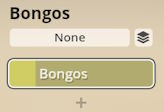
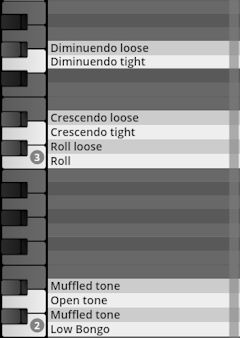
Cowbells
Cowbell sets 1 and 2 (5 each)
- Wood, triangle, wool beaters, rasping stick, bow (set 1 only)
- Single notes, top and edge
- Rasping stick: slow and fast
- Bow: normal and overtones.
- Mapping: each cowbell of a set is mapped to an octave, starting at C2.
- Cowbell set: A0/B0.
- Beater: C1–E1.
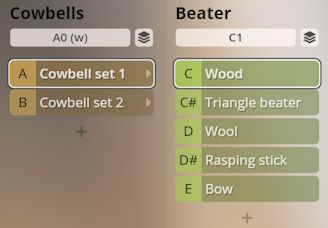
Mallets and beater
Top and edge hits.
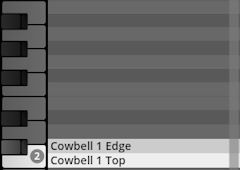
Rasping stick, set 1
Fast and slow rasps.
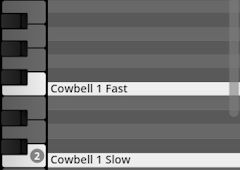
Rasping stick, set 2
Fast and slow rasps, 2 variants.
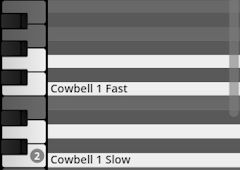
Bow
Normal tone and overtones.
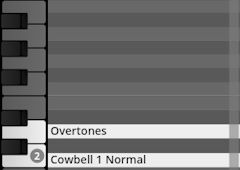
Guiros
Wood and gourd guiros
- Single strokes, slow and fast, short, very short, and long
- Hits + crescendo
- Repetitions slow and fast, var. 1–4.
- Wood/gourd guiro: C2/D2.
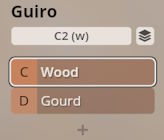
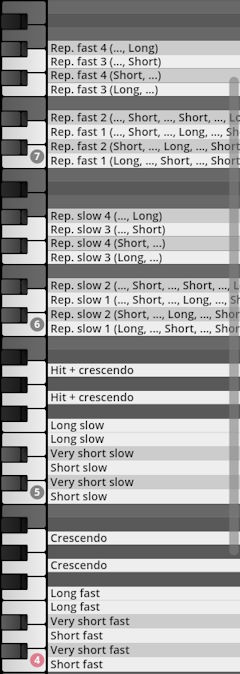
Claves
Fiber and wood claves, low and high
- Single hits
- 1–3 upbeats.
- Mapping: in the set, the claves are each mapped to an octave, starting at C3. The individual claves all start at C4.
- Claves: C2–E2.
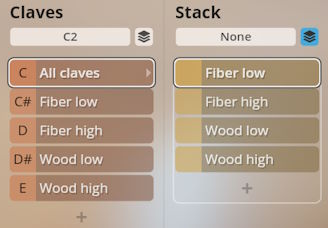
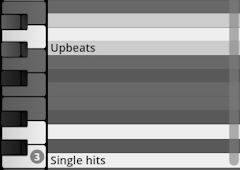
Wind chimes
Glass, metal, and bamboo chimes
- Single strokes, slow and fast
- Double strokes
- Tinkling
- Damped strokes.
- Chimes: C2–D2.
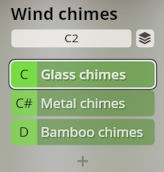
Glass
Strokes up, down, and cross.
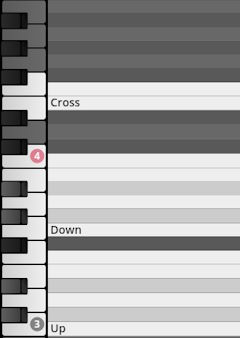
Metal
Strokes up, down; tremolo low and high; damped low and high, 2 variants.
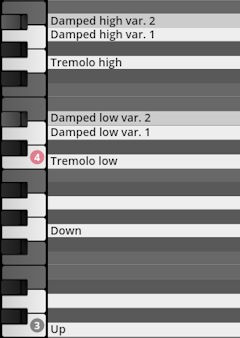
Bamboo
Strokes up and down, slow and fast, low and high; combination strokes; tremolo low and high; damped low and high, 2 variants.
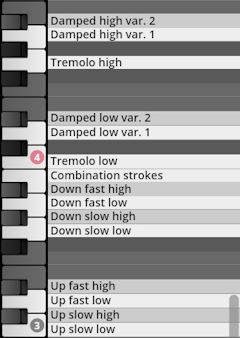
Shaker
Bamboo, chrome, and kiwi-shaped shakers
- Single shake
- Upbeats shakes, slow and fast
- Static roll
- Dynamic rolls, regular, accelerando and ritardando
- Repetitions, slow and fast.
- Shaker: C2–D2.
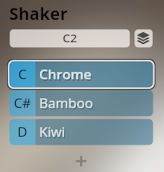
Chrome, bamboo
Single shake; upbeat shakes slow and fast; roll; crescendo and diminuendo 1/2 sec.; accelerando and ritardando; slow repetitions normal and with accents; fast repetitions.
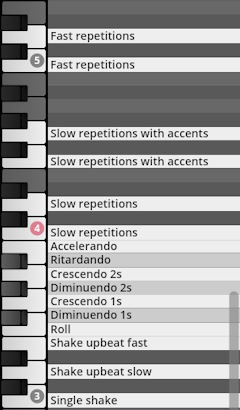
Kiwi-shaped
Single shake; upbeat shakes slow and fast; roll; accelerando and ritardando; slow repetitions normal and with accents; fast repetitions.
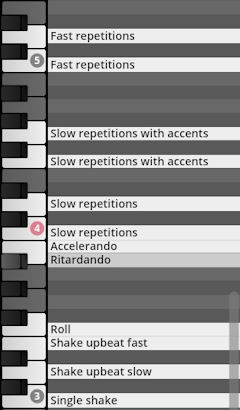
Caxixis
Low, high, double caxixi
- Single shakes
- Upbeat shakes, slow and fast
- Repetitions, slow and fast, piano and forte.
- Caxixi: C2–D2.
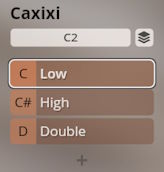
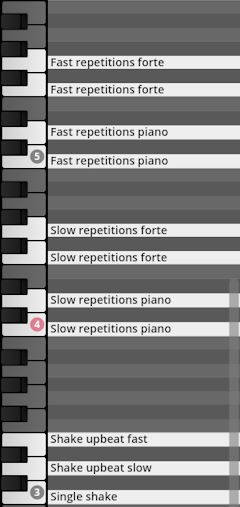
Rainmaker
Rainmaker 1–3
- Very slow, slow, fast sounds
- Rainmaker 3: slow, medium, fast patterns.
- Rainmaker: C2–D2.
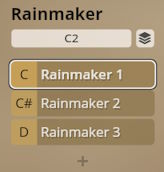
Rainmaker 1/2
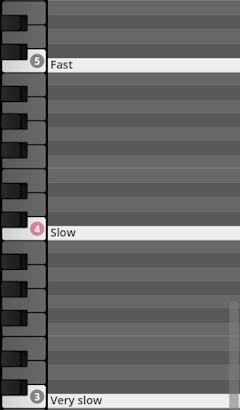
Rainmaker 3
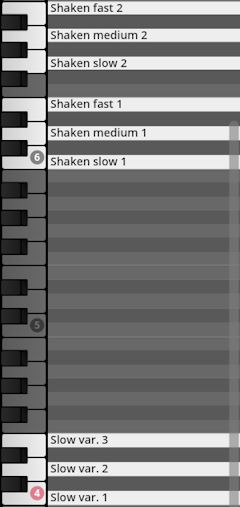
Cuicas
Cuica 1–3
- Short, medium, and long tones, piano and forte
- Effects
- Cuica 3: free performance.
- Cuica: C1–D1.
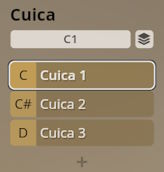
Cuica 1

Cuica 2

Cuica 3

Wind machine
Sound variations 1–7. Mapped to white keys.
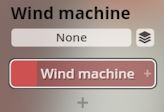
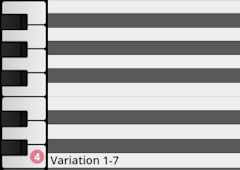
Thundersheets
Thundersheet A, B, C, D, E
- Single hits, various beaters
- Shaken
- Bowed
- Hand rub
- Thundersheet E: free performance.
- Thundersheet: C2–E2.
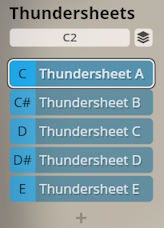
Thundersheet A, B, C, D
Single hits regular and with chain; shaken, piano and forte (except D); bowed; hand rub; tremolo. The number of variants differs according to instrument.
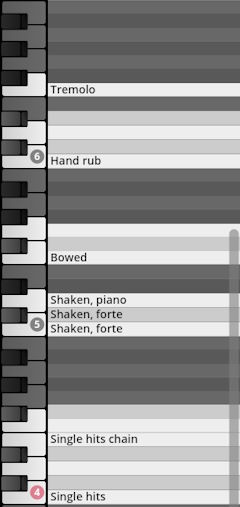
Thundersheet E
Free performance; single hits; shaken.
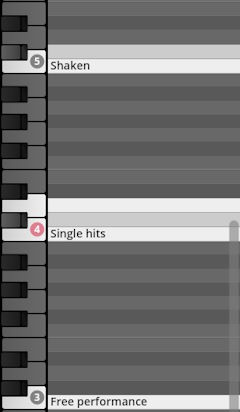
Ocean drums
Ocean drums A and B
- Short and long
- Motion sounds
- Performances, full and excerpts.
- Ocean drum: C2/C#2.
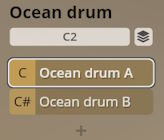
Ocean drum A

Ocean drum B
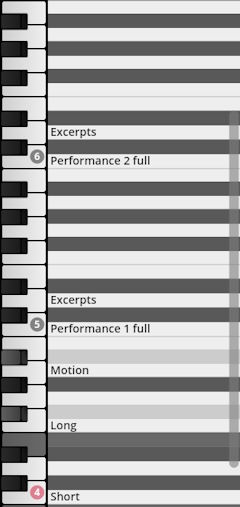
Gunshots
6mm pistol, 6/9 mm revolver
Single and double shots, wet and dry.
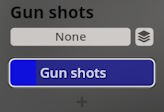
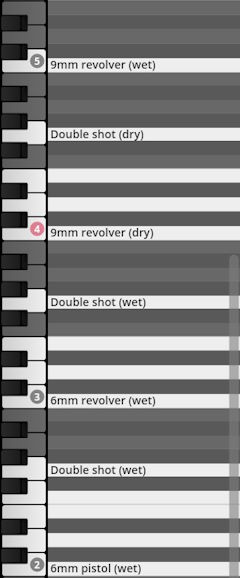
Waterphone
Sustained, bow, straight and modulated
- 3-note arpeggios
- Effects: glissando slow and fast, spherical, multiphonics
- Pizzicato
- Repetitions, long and short release.
- Articulation: F1–A#1.
- Release: A0/B0.
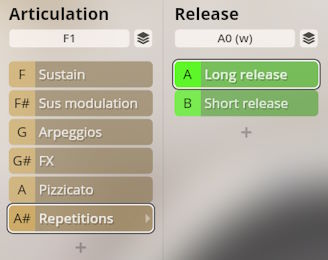
FX
The Patch contains various effects that can be created with the waterphone, ranging from pizzicato tremolos to multivoice bowing with repetitions. Most of these effects have two variations, each mapped to two keys to allow for a little transposition. Some of the samples are quite long, so – hold the key!
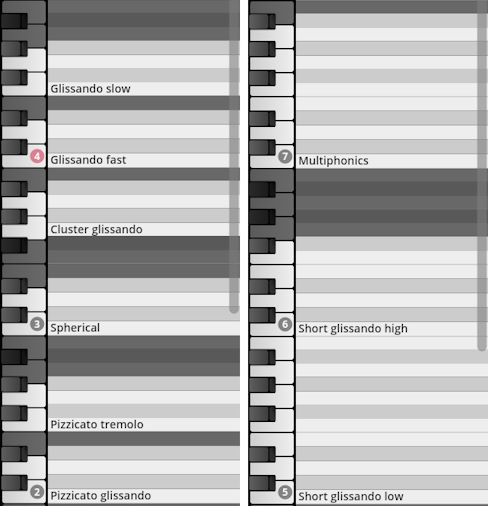
Jingle rings
Jingle rings A, B, C
- Single hits with and without attack
- Rolls normal and dynamics
- Spins
- Repetitions slow, medium, fast.
- Jingle ring: C2–D
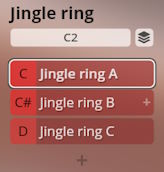
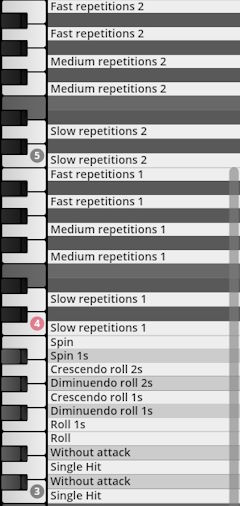
Ratchets
Ratchets 1–5
- Staccato
- Short, medium, long tones.
- Mapping: in the set, the ratchets are each mapped to an octave’s white keys from F to B. The individual ratchets all start at F4.
- Ratchet: C1–F1.
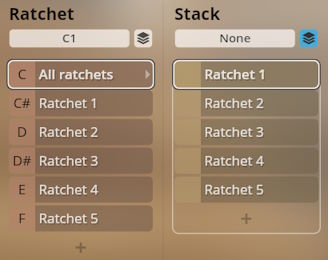
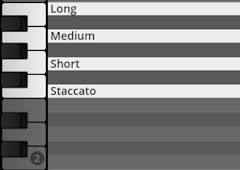
Sirens
Sirens 1–3
- Duration 13 to 56 sec.
- Siren 1: dry and wet.
- Mappping: Each siren is mapped to an octave (white keys), siren 1 to separate octaves for dry and wet samples.
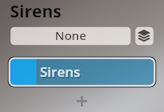
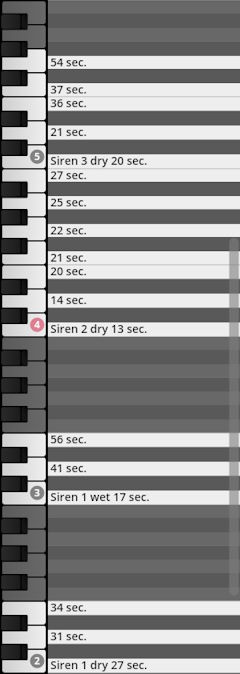
Bull roarer
6 performances, 14 to 73 sec.
- Full samples with 3 to 8 excerpts each.
- Mapping: Performances plus excerpts are each mapped to an octave.
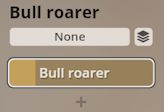
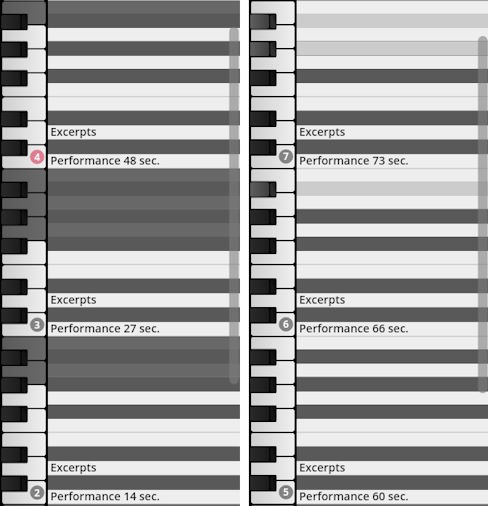
Spring drum
2 spring drums
- Pizzicato p–ff
- Finger slides and snips
- Rotation
- Pulses.
- Mapping: Sping drum 1: C2–A3; Spring drum 2: C4–F#7.
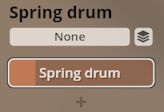
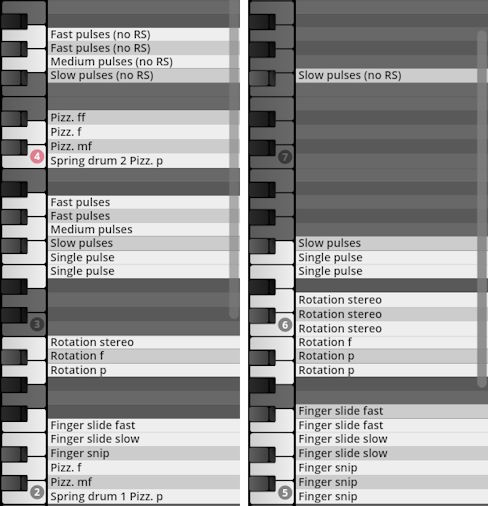
Vibratones
Vibratone 1 and 2
- Single strokes, constant pitch
- Modulation up, down, up/down, down/up
- Multiple modulations
- Tremolo regular, accelerando and ritardando.
- Vibratone: C2/D2.
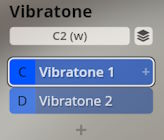
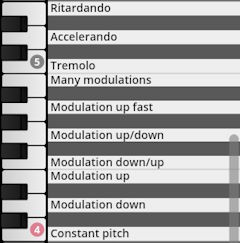
Flexatones
Large and small flexatone
- Large: steady tones, 2/4 sec.
- Small and octave (large only) glissandos up and down, 2 and 4 sec.
- Performances 1/2, full samples with 4 and 5 excerpts
Large flexatone
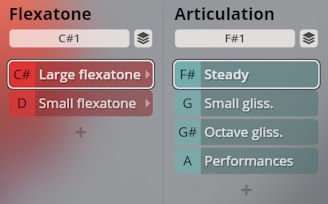
Steady
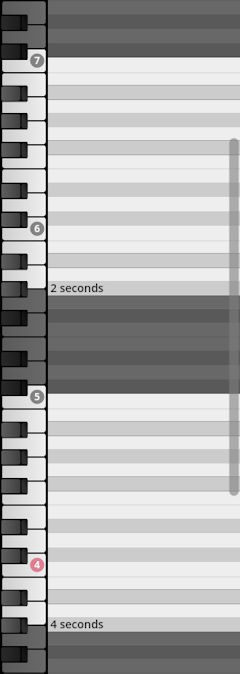
Small glissando
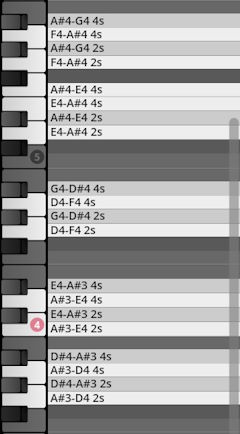
Octave glissando
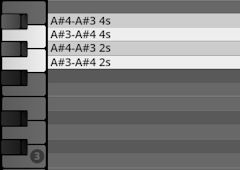
Performances
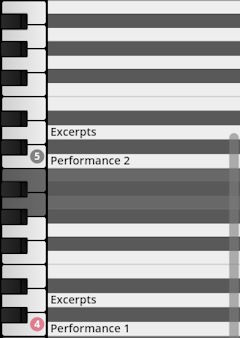
Small flexatone
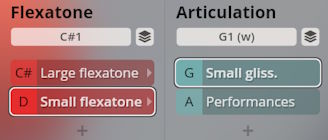
Small glissando
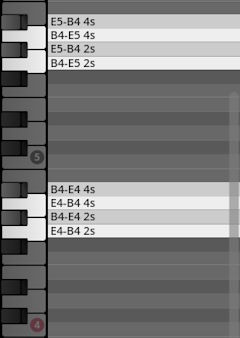
Performances
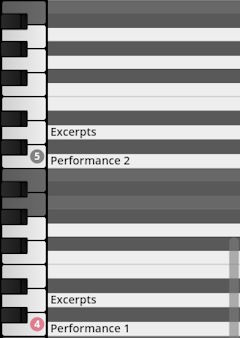
Angklung
Single notes, 0.5/1/2 sec.
- Range: F3–D6.
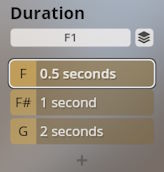
Waldteufel
Large and small waldteufel
- Short, medium, long, and extra-long sounds with variations.
- Large/small: C2/C#2.
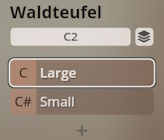
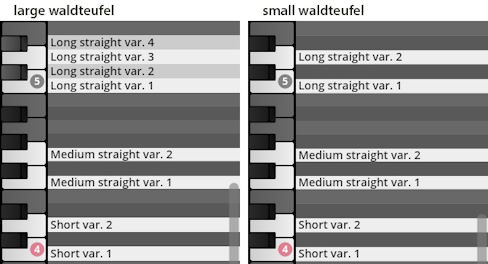
Lion’s roar
Short, medium, and long variations
- Tremolos.
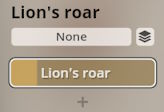
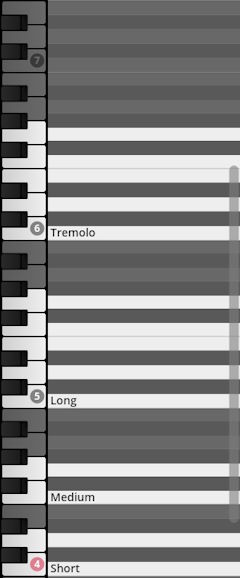
Honks
Car honks, single notes open and muted
- Bicycle honks, single ntes low and high, changing notes, open and muted.
- Car/bike honks: C2/C#2.
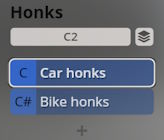
Car honks
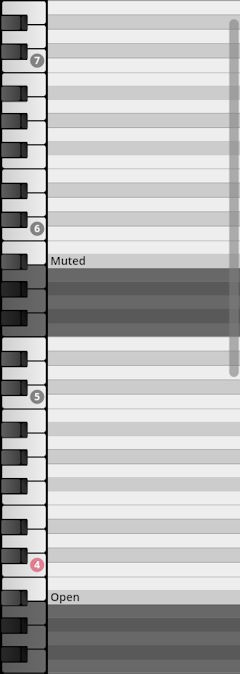
Bicycle honks
